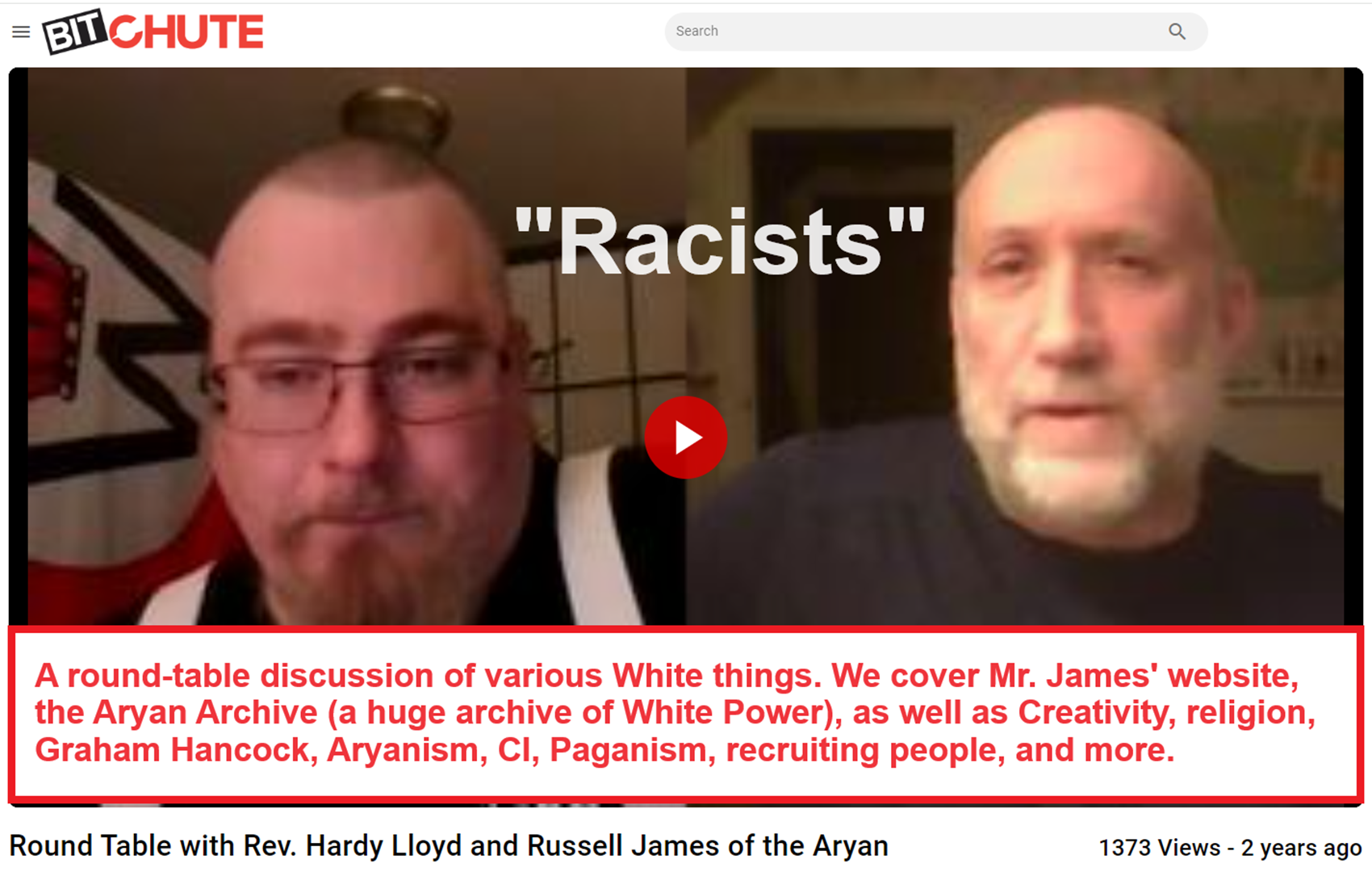

“White supremacists talking about the usefulness of Graham Hancock theories for white supremacists talking about Graham Hancock’s work. I thought you might get a kick out of it. The discussion starts at :58 and runs to about 1:08. https://www.bitchute.com/video/JaKq2unoa2ub/ Hardy Lloyd recommends white supremacists use Hancock’s “Fingerprints of the Gods” to recruit people to the cause. He’s currently serving a six-year sentence in federal prison for threatening jurors and witnesses—especially Jewish ones—in the Tree of Life mass homicide case in Pittsburgh. That blog post has a wealth of information and links. Thanks! By the way, I learned about that white supremacist video because Stephanie Halmhofer cited in her recently published book chapter. (Conspiracy Theories and Extremism in New Times: Conspiracy Theories and Extremism in New Times outlines a cadre of alt-right groups, conspiracy theories, and other forms of stigmatized knowledge threatening our society.)” – John Hoopes (in a message to me)
Here is a sample of the racist trash explaining their thinking from the video:
Main racist commentor: “I am a creator, whatever the scientific data is, whatever makes the logical sense. Even if there is not a lot of data to back it up, if it is logical, I am going to tend to believe that. Some people believe this Aryan mythos: basically white people, basically the master race, evolutionary, we create things others don’t create, such as the pyramids… That is the only mythos I need; people like to dress it up.”
Other racist commenter: “I want to get back to Graham Hancock”
Main racist commentor: “Graham Hancock made a Netflix series, that the libtards hated, oh know, white people are the master race…”
Other racist commenter: “20 years ago, I saw a video he did. Graham Hancock’s claim in the video, which I agree with, great stuff. Is that there was a group of people the navigated the globe, 12,000 years ago. I always felt he was saying/implying it was a group of Aryans or proto-Aryans, but never says it, he secretly thinks it was a master race.
Main racist commentor: “Long story short, Hancock basically says, Aryan without saying Aryan. He constantly recites ancient texts, saying white-skinned people, white skin people with beards, white-skinned people with blue eyes, or white people with gold or red beards, and he will write that. To tell you the truth, I am surprised, it has taken this long to slander the guy. Because as soon as Handcock came out with this Netflix documentary, all of a sudden, the Jew media, started bashing Handcock. Interesting that he was saying this stuff like 20 or 30 years ago. When he first published, “Fingerprints of the Gods”, he is basically saying, yes, it was white people, ancient white men created everything. I am surprised it took so long for people to attack him, Handcock is basically a mouth pace for the SS, read his books, it is like reading something from the third Reich. I read Fingerprints of the Gods, five times, and I use it as a resource all the time, I think it a great tool (for white supremacists). I like Handcock, it’s like listening to some third Reich archaeology, without any of the baggage. So, I can watch it with somebody else (not white supremacists), it is a good way to introduce people to white superiority. Here, check out this Handcock book, and if they agree with it, then maybe they are open to reading, more clearly white supremacist stuff. Handcock books are a nice intro to (white supremacist thinking) racialism, at least that is my thinking.
Other racist commenter: “Yeah, I have been looking for a source like that, something more mainstream, granted it is mainstream alternative, Handcock does not have the stigma of right-wing, but rather more left-wing conspiracy thinking. So, you can use him to get to people.
Main racist comment: “I sometimes post his stuff on my (white supremacists) blog; it’s good stuff, it is all science, and since he cites every reference, it is all fact-based, and it is kind of racialism without the stigma. For anyone watching this and you are racial and you want them to think about racialism, give them a copy of Handcock’s Fingerprints of the Gods. Use that as an opening, saying hey, what do you think about this. Then it opens them up because Handcock says all the time that the Inca said white people built this. Aztecs said, white people built this. Ancient Hindus said, white people built this. Throughout the whole book, it is like this (racialized), but it is not in your face. So, I think Handcock is good to use, on people that are fence sitters, or maybe they are not racial at all.”
To me (Damien Marie AtHope), Pseudoscience and Pseudoarchaeology are true enemies of humanity, as well as attack truth, trying to replace it with errors. I know for a long time, I thought Pseudoarchaeology was harmless nonsense. But I have come to understand, just how much harm Pseudoarchaeology truly is. I now see the often hidden harms of Pseudoarchaeology, such as racism and other kinds of hate, including mistrust or hate of historians, anthropologists, and archaeologists, as well as all manner of others in science-related topics. I am always amazed at how “Pseudo-History-Thinkers” make up nonsense about history, when the real history is already amazing, and doesn’t need lies added.
From Twitter/X
John Hoopes @KUHoopes, “One of the most annoying things about Graham Hancock is how he actively perpetuates willful ignorance among his fans. For example, he will imply that almost nothing is known about Tiwanaku, a culture that archaeologists have been investigating for decades.”
Digging Up Ancient Aliens @DUAncientAliens, “The ancient alien crowd has done the same for years. What I find a bit amusing is that they always want to separate Pumapunku from Tiwanaku as if these are two different locations:
The non-mystery of Puma Punku and Tiwanaku https://diggingupancientaliens.com/episode-45-pumapunku-tiwanaku.html
Paul Barford @PortantIssues, “Perpetuates with confidence”, because he knows for sure that 97% of them are shallow-minded gullible buffoons who’ll never so much as lift a mouse-clicking finger to check for themselves…”
Sam Leeming @SamLeeming, “Jordan Peterson uses the same obfuscating techniques to sidestep any direct questions that require a definite answer. We don’t know anything…. Everything’s just too mysterious. “weaponized relativism,” undermines trust in reliable sources of information. https://www.youtube.com/watch?v=C2CuAVAERjs“
Justine “That Woman” Warren @adancingferret, “If they go looking for information they might start to question his interpretations. Can’t have that! Best to imply there isn’t much more than what he’s telling them.”
P J @PJ11819211, “Graham Hancock and co have created this weird strain of conservative glue eaters convinced archeology rigor is a conspiracy by the (((elites))) to prevent everyone else from being Indiana Jones.” And “No one of these clowns even have done the necessary work or anything, all they do is point at a site and then throw a tantrum, when internet rando, states, “You can’t dig the site willy nilly, without permission, or oversight from academic institutions.”
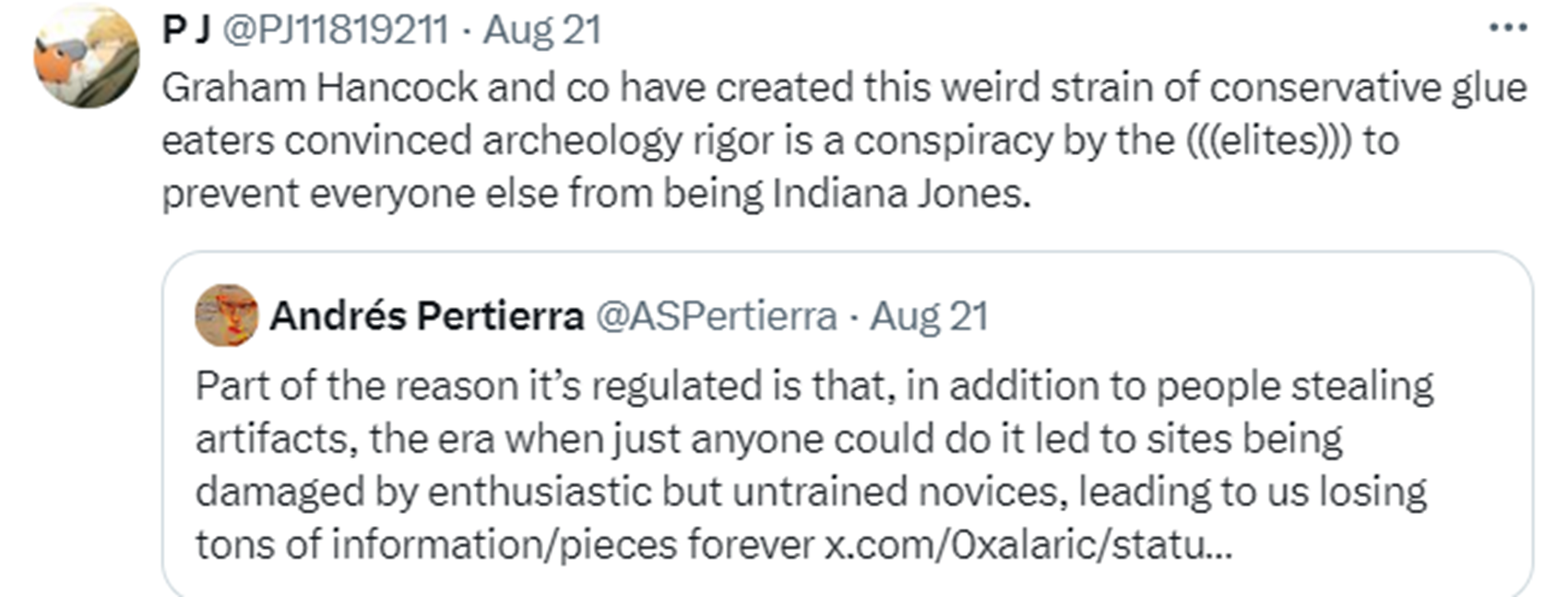
P J @PJ11819211, “There is a good reason why Graham Hancock has become more explicitly partisan and right-wing recently, because he needs to draw the most gullible, stupid, and tribalistic foot soldiers for his grift. The silliest bit honestly is the fact that you can actively engage with archeology research, the only roadblock is having an expert or specialist to guide you in the literature, but if you know how to navigate this stuff, you can find out about sites in smallest details. But these factors matter very little, when you really don’t care about the actual archeology itself, and are more obsessed with a pathetic loser persecution complex, about how the evil elites are trying to hurt your little tribe.”
Juli Ruth Emry @Parodyite, “This is another misunderstanding (misrepresentation?) of how science works. Scientists don’t say “this IS the way it is”. Most scientists say, “this is the way we think it is based on the data we HAVE.” Hypotheses/ideas evolve all the time with new data/studies. I’m a poster child for challenging a long-held interpretation/hypothesis in my PhD research. Some scientists are resistant to change & new ideas (whoo boy, believe you me), but not most. The important thing is the preponderance of evidence based on multiple studies. Um….scientists prove things (hypotheses) false or “not to be the case” all the time. This is the basis of hypothesis testing – make a hypothesis, collect & analyze data, and accept or reject the hypothesis. The preponderance of evidence (or lack thereof) across different studies is key. Philosophically maybe not, but at any specific time, someone might find evidence in the future. But, as of now, based on decades of research/studies on thousands/10’s of thousands of Ice Age sites – no evidence exists. Therefore, practically, as of now, based on the data we have, the hypothesis of an advanced Ice Age civilization has been rejected. That’s how science works. The “lost & then found” metric for an advanced Ice Age Civilization is a classic red herring. Quite a few Pleistocene sites have been ID’d & studied. It’s probability – if it existed it’s unlikely that we wouldn’t have seen SOME kind of verifiable data for it. Typically, sites aren’t found “just by accident” b/c humans are dependent on necessary resources that occur in certain environments. Looking for a Pleistocene archao site in an ancient river floodplain deposits is more reasonable than looking in a granite batholith. ”
Joseph A P Wilson @JosephAPWilson1, “Speculation must be grounded in reality for it to be taken seriously by scholars. Hancock wants to be judged on a sliding scale, and given a free pass for a zillion errors on the grounds of his amateur status, while still taken seriously as a critic on matters not yet proved.”
Paul Barford @PortantIssues, “In a realm where facts are not as powerful as narratives, it is not enough to just debunk pseudo-archaeological content. We must also dismantle the harmful narratives pseudo-archaeology is used to support”. @DeDunkingPast, @Graham__Hancock, and @BrightInsight6“
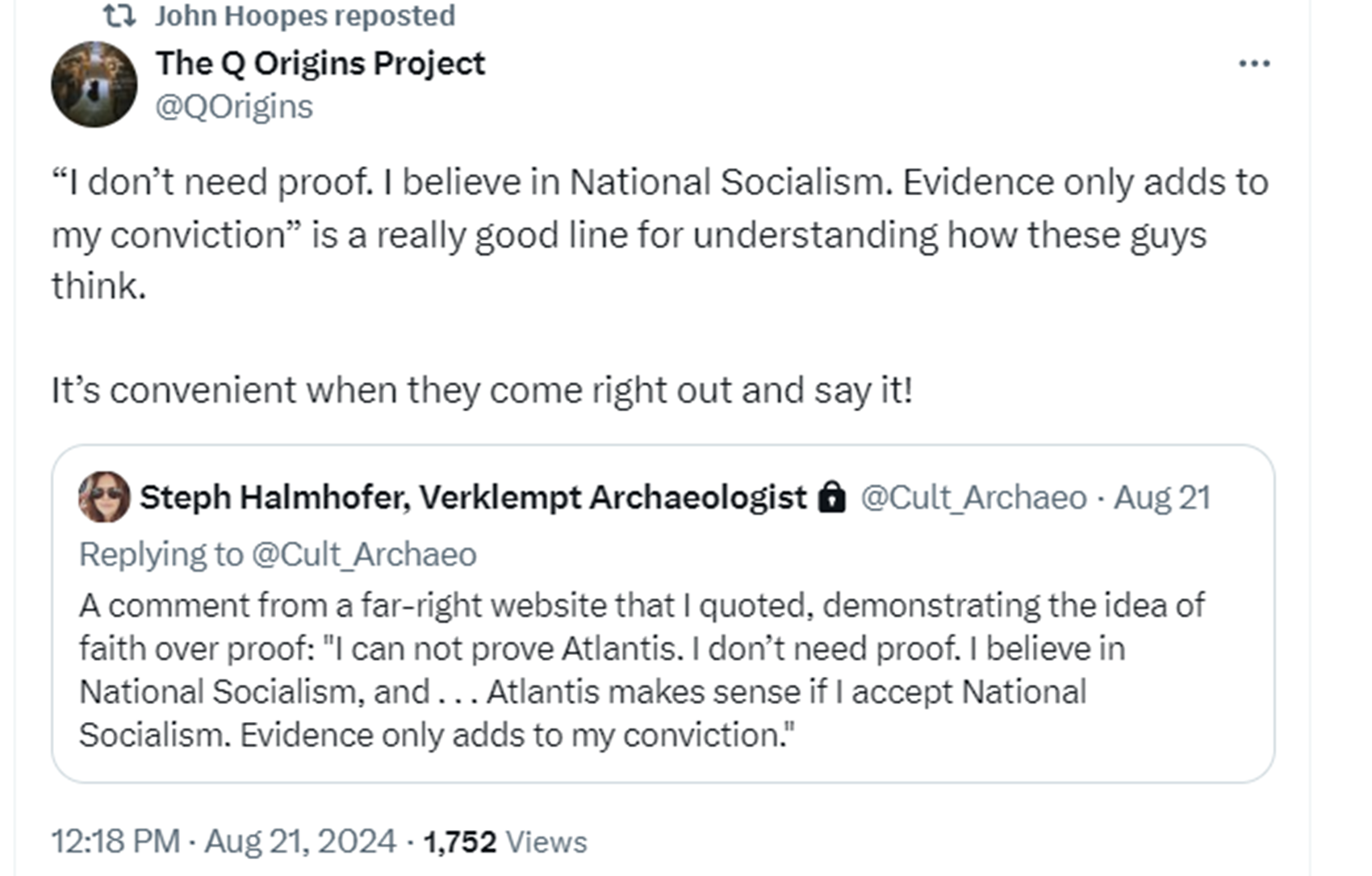
Steph Halmhofer, Verklempt Archaeologist @Cult_Archaeo, “A comment from a far-right website that I quoted, demonstrating the idea of faith over proof: “I can not prove Atlantis. I don’t need proof. I believe in National Socialism, and . . . Atlantis makes sense if I accept National Socialism. Evidence only adds to my conviction.”
Liminalitytv @liminalitytv, “Despite this evidence that he is, in fact, an Atlantis believer; he thinks me calling him one is disrespectful, and that by pointing out that he believes in Atlantis theories, that I was personally attacking him. All I did was call a horse a horse. ‘If you cared about the material, you’d engage with argument, not personal attacks’. And in the same post he attacks my appearance. I’m sorry I don’t have blue hair and a nose ring, maybe that would have been better material for you? @ill_Scholar, You seem to think I believe I’m some kind of elite PhD grant-getting globe-trotting archaeologist. I don’t have a PhD either, lol. You don’t need one to be an archaeologist in Australia. With regard to your video; this is about maritime archaeology. I am not a maritime archaeologist. I have never practiced maritime archaeology. Other than what’s relevant to the important sites and cultural heritage management in Australia, my knowledge is limited. I would never come on your show and pretend to be an expert in something I’m not, unlike some people. Archaeologists aren’t out there in the shadows waiting to get you mate, we’re not part of some academic elite. Most of us breathe dirt, sleep in tents, and wear the same clothes for weeks at a time. Lastly, you said I would never call you an ‘Atlantis believer’ to your face. Yes, I would. And we’d have a good laugh arguing about it over a beer. I called this guy an ‘Atlantis believer,’ and he’s had a full-scale meltdown. His response was, ‘You couldn’t even check the evidence on my profile to know you’re wrong.’ when I said he believed in Atlantis. He talked about Atlantis ‘…I don’t think I’ve ever claimed to think it definitely exists’. But look at his profile.”


Rabbit Hole Cartographer @QuacksAnonymous, “I define pseudo-archaeology as speculative and alternative claims made about human history using archaeological knowledge, but which rely on a matter of faith rather than a matter of proof by willfully and deliberately downplaying or ignoring contradictory archaeological knowledge under the guise of stigmatized knowledge, placing pseudo-archaeology within the same realm as conspiracy theories.” — Stephanie Halmhofer (@Cult_Archaeo) – “Manufacturing History: Atlantis, Aryans, and the Use of Pseudoarchaeology by the Far-Right”

Matthew T. Boulanger @MTB_Archaeology, “Pseudos in Archaeology are now associating the belief in Atlantis with “far-right extremism and Fascism” They’re selling these Textbooks for hundreds of dollars. Pseudoscientific Archaeology has been corrupted to its core. Totally shameful, @BrightInsight6.”

Justine “That Woman” Warren @adancingferret, “Ironically, the ADL actually included Graham Hancock in their seeding terms for a limited study on the impact of algorithms on the spread of online extremism and antisemitism… In the continuing adventures of integrity dances naked in front of DeDunker with a damn LED sign reading “FFS, are you blind?” let’s talk about the ADL and what they have to sat about online extremism, the propagation of antisemitism on social media, and how Jimmy Corsetti:
1/ “‘Why do people trust Dan more than us on this stuff?’” Well, that’s a great question, Dan. Because I have to wonder why anyone who troubles to read the entire thread would trust you on “this stuff.” https://x.com/adancingferret/status/1825423899452178497?s=46
2/ Dan, I’ve noted before that failing to read fully is a recipe for disaster. I’ve made no claim that the ADL should be ignored nor considered inexpert regarding white supremacy I have cited the work of another well-known expert authority on extremism and hate groups – the SPLC
3/ I have further cited the work of the ADL regarding the WEF and extremism and hate a topic about which you are by your own admission unfamiliar, but should probably, as a matter of integrity, familiarize yourself with, particularly if you want to claim them as a broad authority
4/ To address another point that seems to be relevant to your audience: – I’m allergic to cats. I do have a delightfully vicious little dog. “Dog lady” is, therefore. more appropriate and probably closer to what I’m sure a few of them have already or soon will call me, Cat lady.
5/ And finally, to paraphrase my great uncle, Wild Horse Robbins Yew ain’t got more sense than the horse, Dan engages in a whole lot of things that look like that while Dedunker defends him and attempts to claim that there’s no association between some pseudo-archaeological topics, content producers, or associated conspiracy theories and antisemitism and racism. Just as a reminder and because I should have made it more clear: DeDunker has cited the ADL as an authority on at least two occasions by claiming a search for “Atlantis” on their website, turns up no hits. Therefore, not associated with racist, white supremacist ideas. However, DeDunker has yet to explain why, if he says the ADL is an expert source about racism, it apparently isn’t an expert source regarding the association of WEF conspiracy theories, like those Jimmy Corsetti engages in, along with other antisemitic tropes as documented in the Threads embedded in the first part of this thread and elsewhere. Well, I have some more awkward information for the Dedunker to digest from the ADL. Probably going to need some Tums, buddy. Graham Hancock also makes a cameo of possible relevance. Turns out, if you search for Hancock on the ADL website you do get a hit that mentions him, despite Dan’s claim to the contrary earlier this year. Let’s have a look. It’s a PDF of a report about antisemitism, extremism, and social media algorithms: https://www.adl.org/sites/default/files/pdfs/2023-08/Research-Study-One-Algorithmic-Amplification-of-Antisemitism-and-Extremism-v9.pdf
Justine “That Woman” Warren @adancingferret, “Here’s a screenshot of the executive summary. Basically, on a number of social media platforms, YouTube being a notable exception, searching certain conspiracy theory related topics resulted in the algorithms suggesting a lot of antisemitic content:
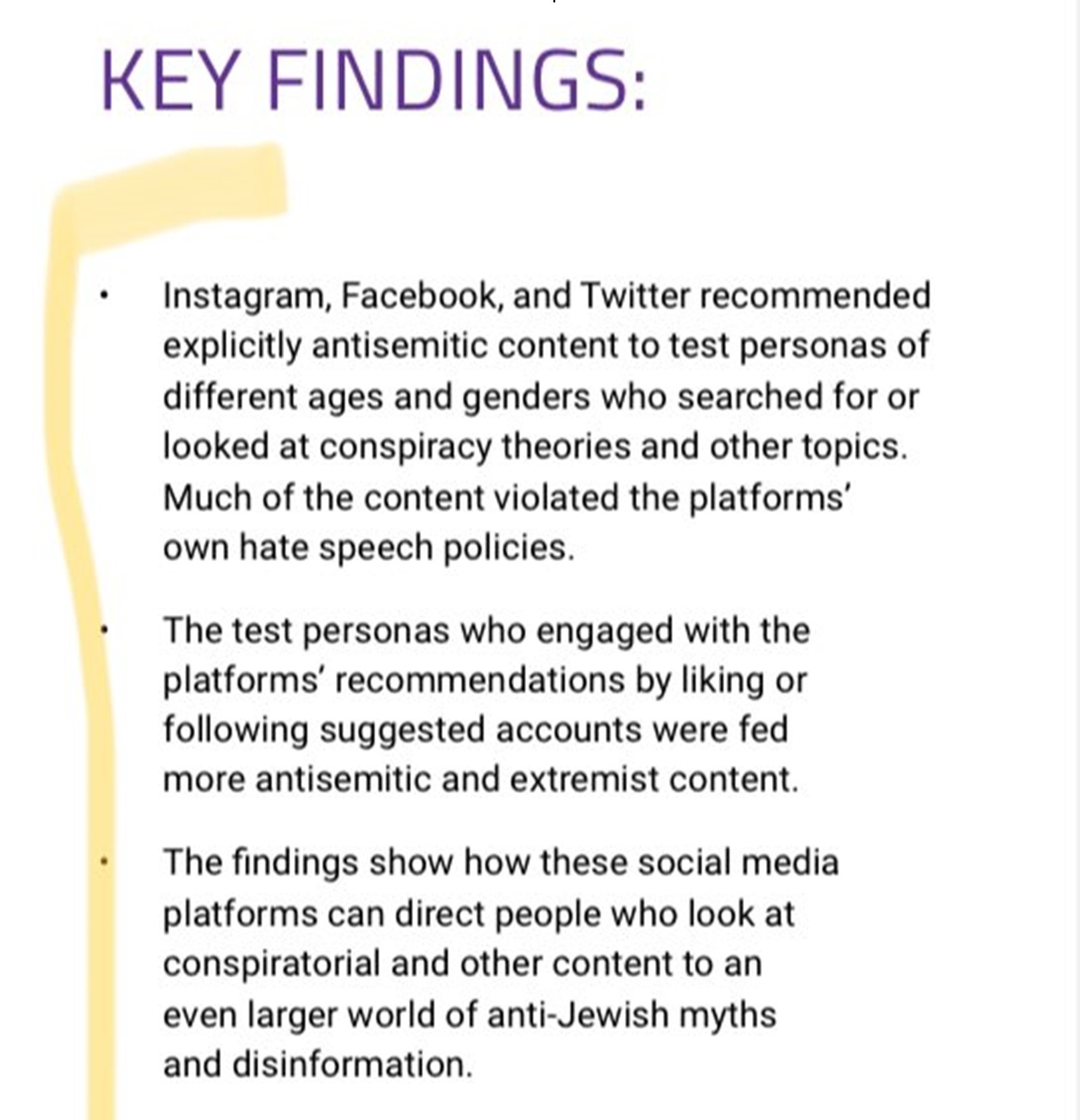

Justine “That Woman” Warren @adancingferret, “The methodology. Basically, they established brand new accounts with various demographic information, including a 14-year-old, and had them search a set of 50 “seed terms” to see what the algorithms spat back out over time:
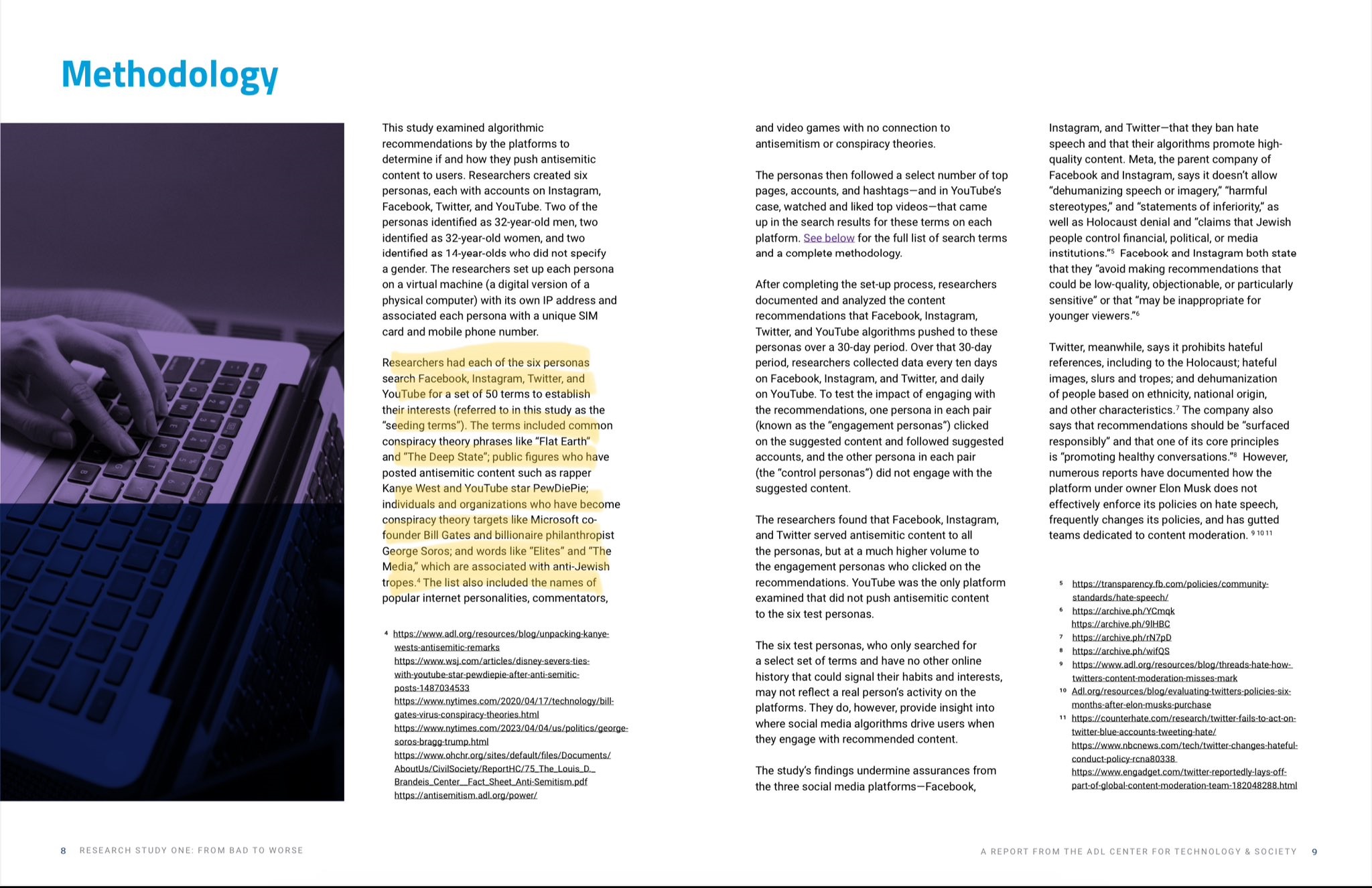
Justine “That Woman” Warren @adancingferret, “Yes, it’s limited. But the results are an interesting look at how seemingly innocuous conspiracy theories, topics, etc., can lead into more blatant extremism and antisemitism. The discussion in the report is also extremely interesting in light of Corsetti’s content I’ve discussed; Instagram seems to be the worst offender. Does the meme I highlighted look familiar? And the blood libel mentioned is circulating via Candace Owens lately…”
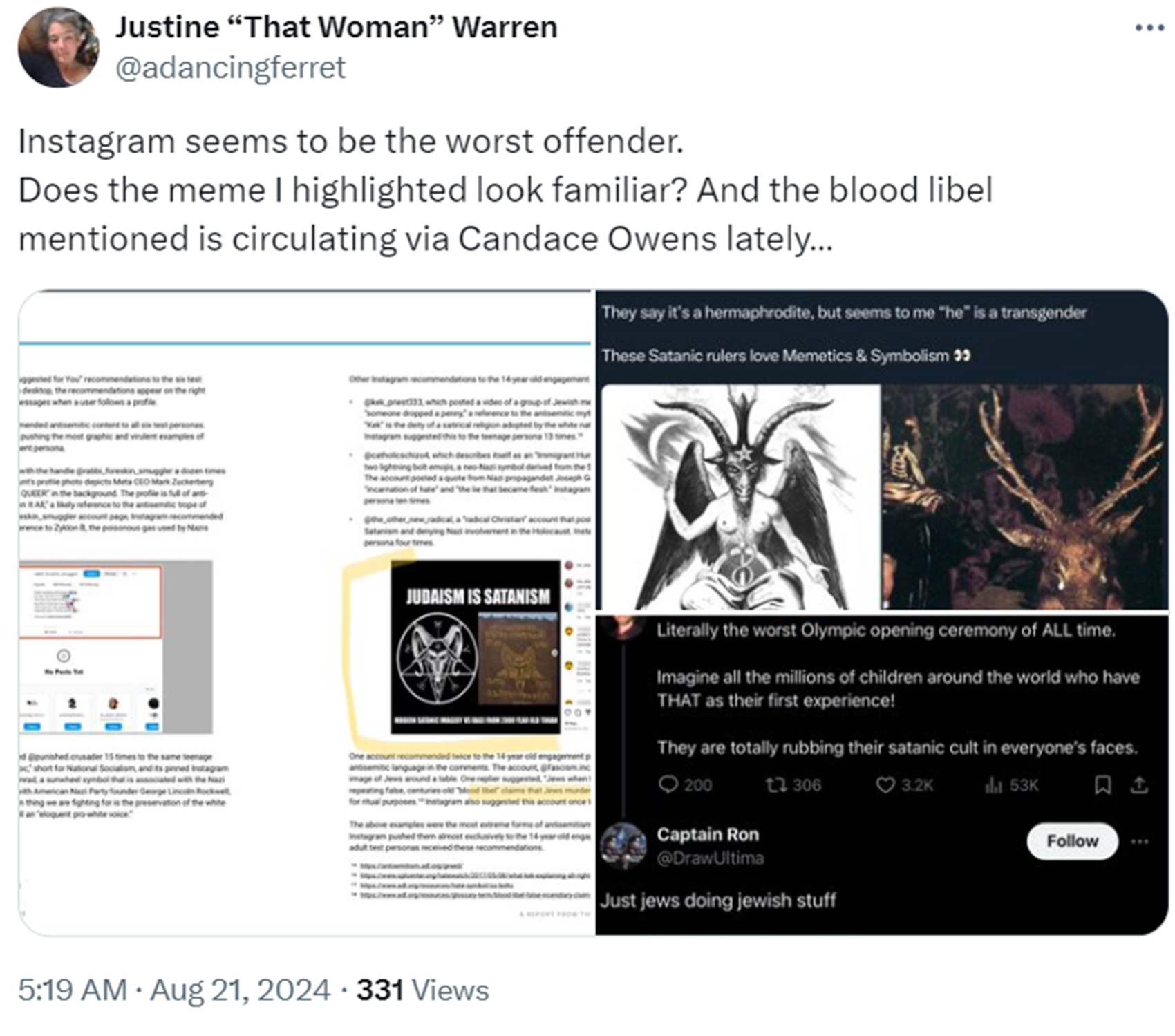
Justine “That Woman” Warren @adancingferret, “Now this is very interesting. One of the accounts recommended by the algorithm posts conspiracy theory memes, including about the Rothschilds. And draws replies with blatant antisemitic content, including the triple parenthesis. And they’ve documented that on Twitter as well.”
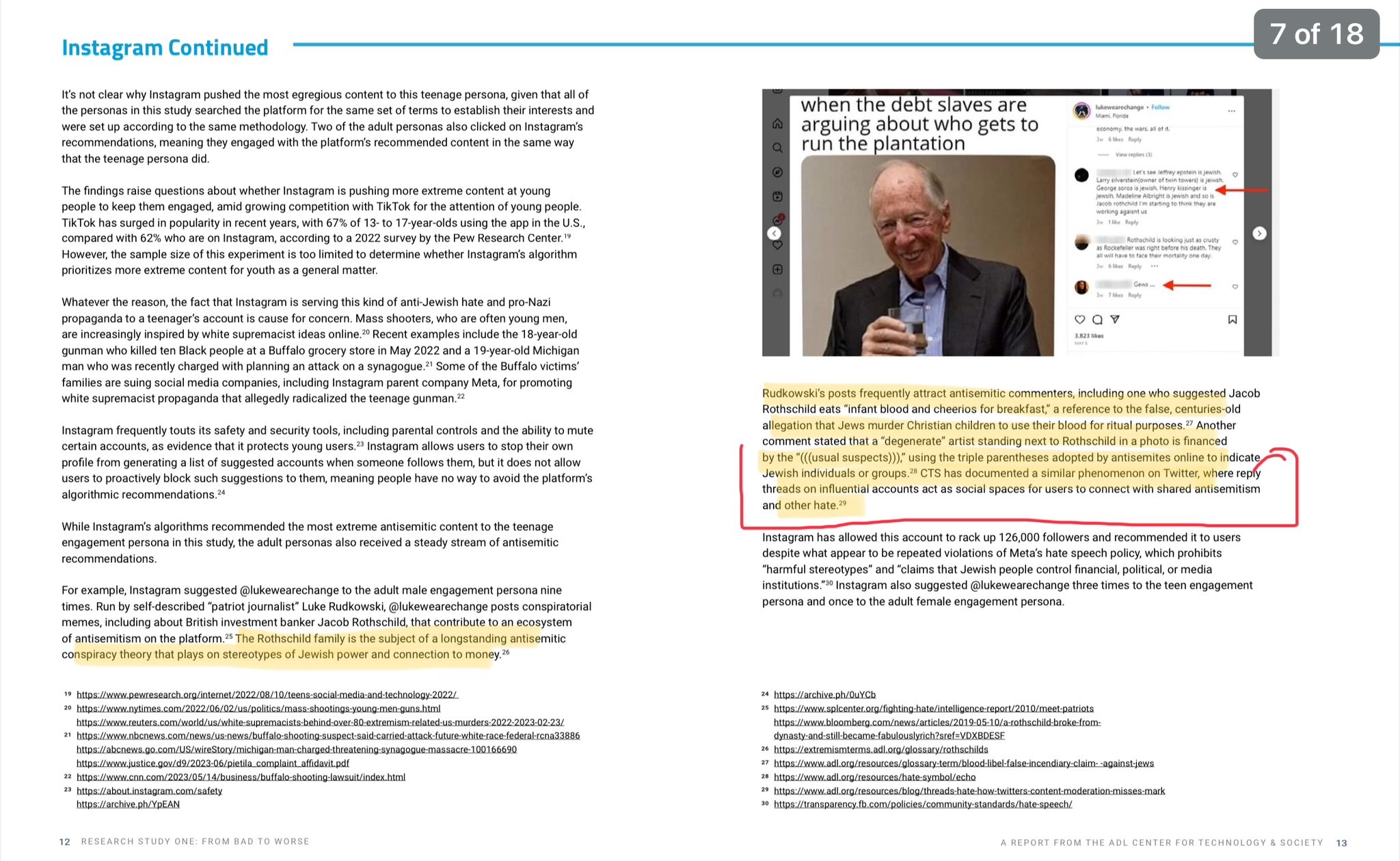
Justine “That Woman” Warren @adancingferret, “Sounds like Jimmy’s content. His “Satanic” photo is from a 1972 costume party held by the Rothschilds. And his replies are loaded with blatant antisemitism and chitchat amongst the antisemites, recommendations for other antisemites to follow, etc.”

Justine “That Woman” Warren @adancingferret, “And here we have more discussion of common WEF conspiracy theories and global control:

Justine “That Woman” Warren @adancingferret, “Here’s some of the results of the study from Facebook. Again, note the Rothchild and WEF conspiracy theories, the UN, global domination. All seen either from Jimmy himself of his followers:


Justine “That Woman” Warren @adancingferret, “Some examples from Twitter:

Justine “That Woman” Warren @adancingferret, “The specific terms the study used as seeding terms They don’t indicate which terms/people on the list are unrelated to conspiracy theories or antisemitism, so I suspect someone might argue Hancock is just a popular online personality. He does engage in conspiracy theories though:
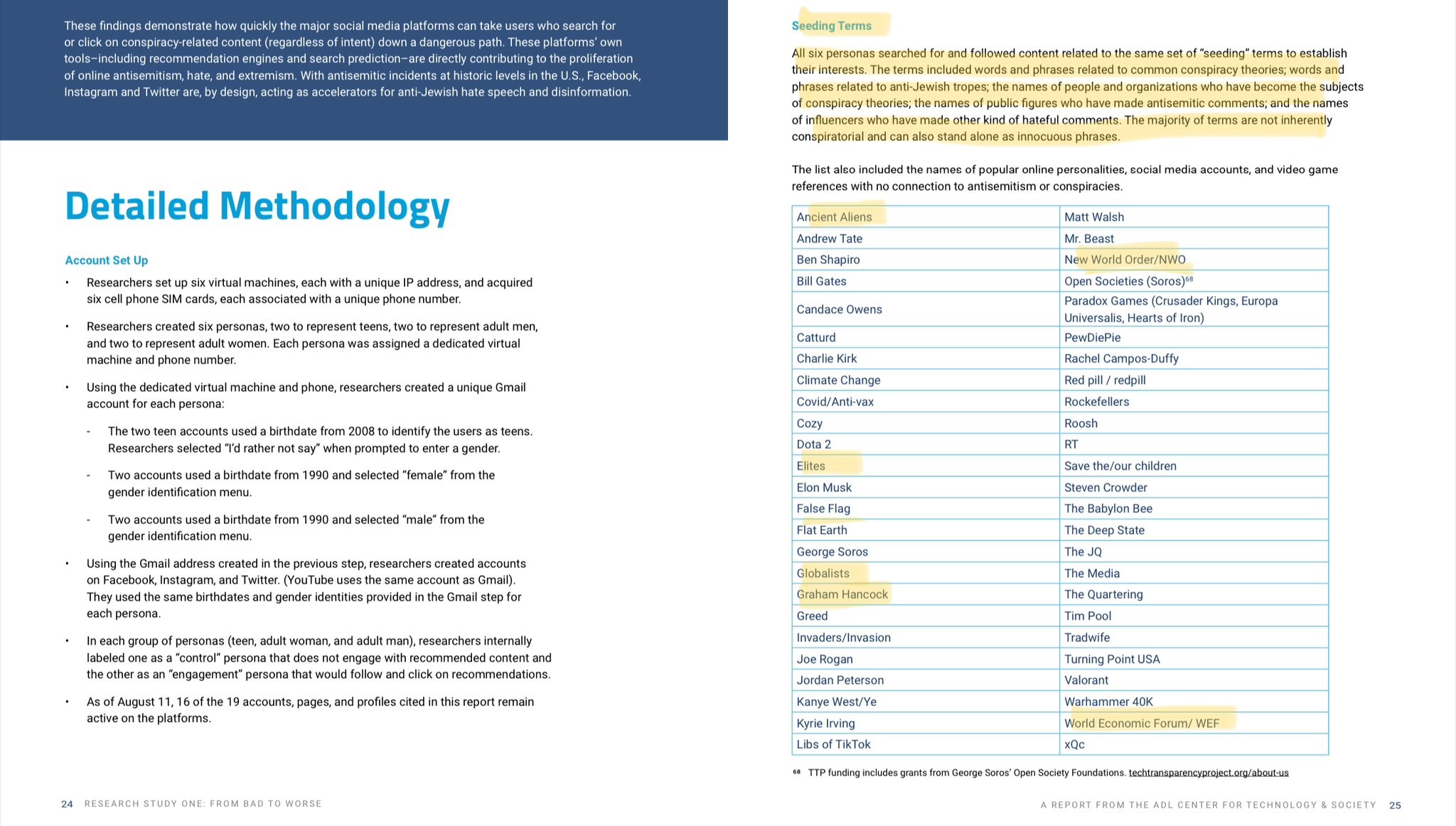
Justine “That Woman” Warren @adancingferret, “So, if one wanted to be extremely picky, it turns out Graham Hancock is mentioned by the ADL. And the study appears to have been released before January. But I’ll refrain from labeling what was likely a mistake as a blatant lie…”
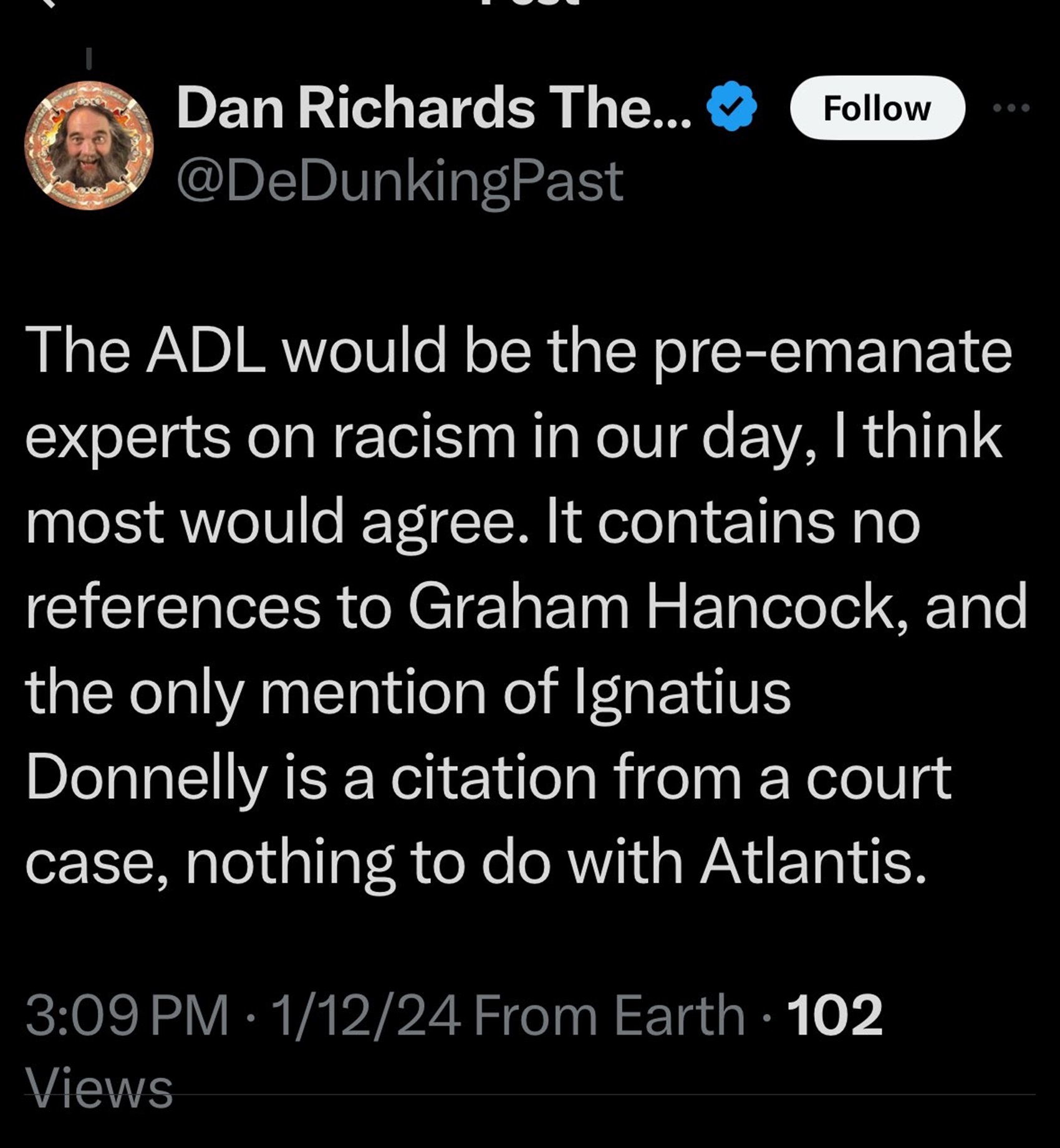
Justine “That Woman” Warren @adancingferret, “Anyway, I encourage people to look at the examples I highlighted here regarding antisemitic tropes & the WEF and at what I’ve documented from Jimmy’s content & replies. And recall that less blatant accounts may attract blatant antisemitic replied and expand those tropes.”

Justine “That Woman” Warren @adancingferret, “Oh dear. I appear to be on a roll. Does this make him a worm, a dumpster fire, a wannabe dumpster fire, or a chickenshit? So much for integrity:

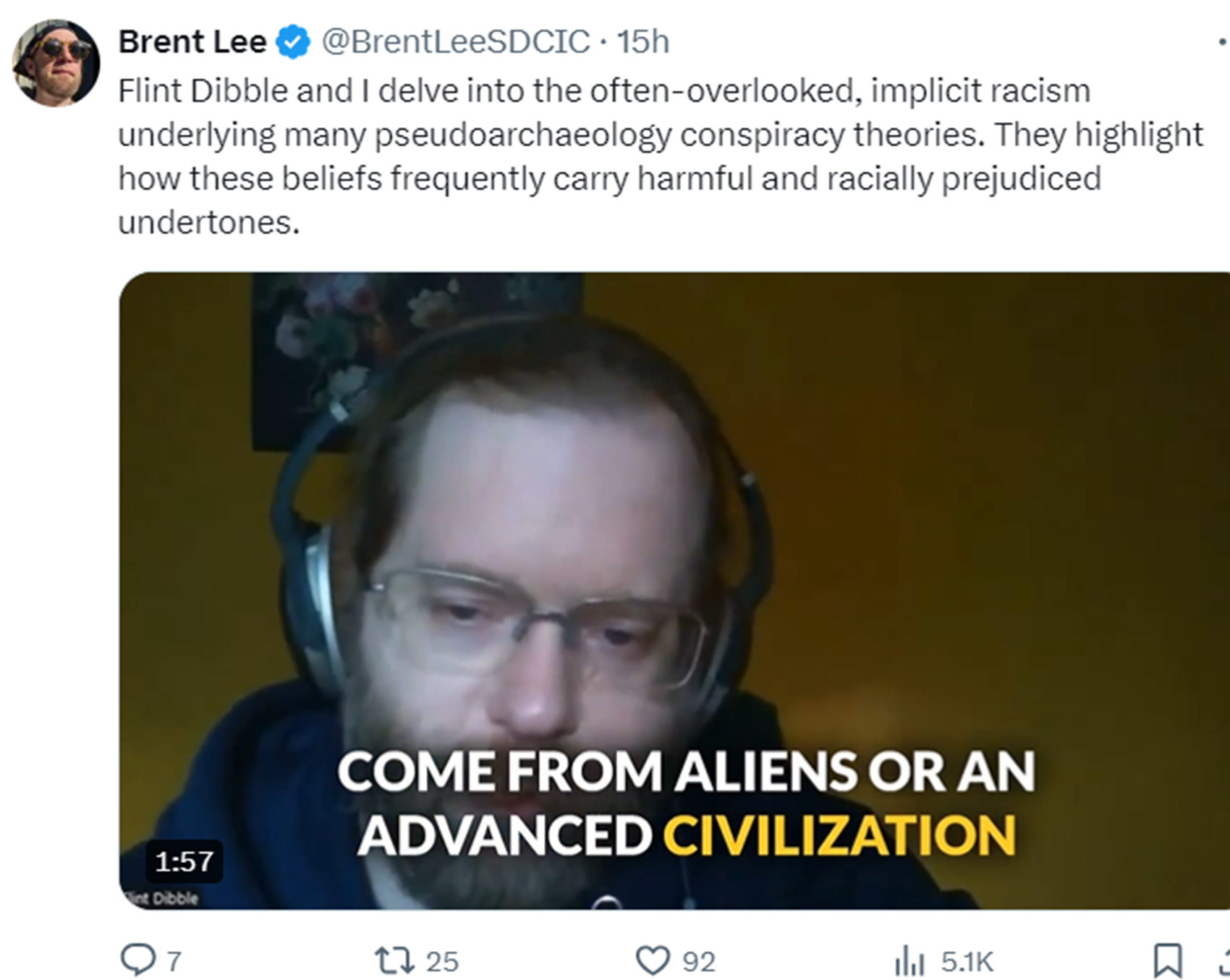
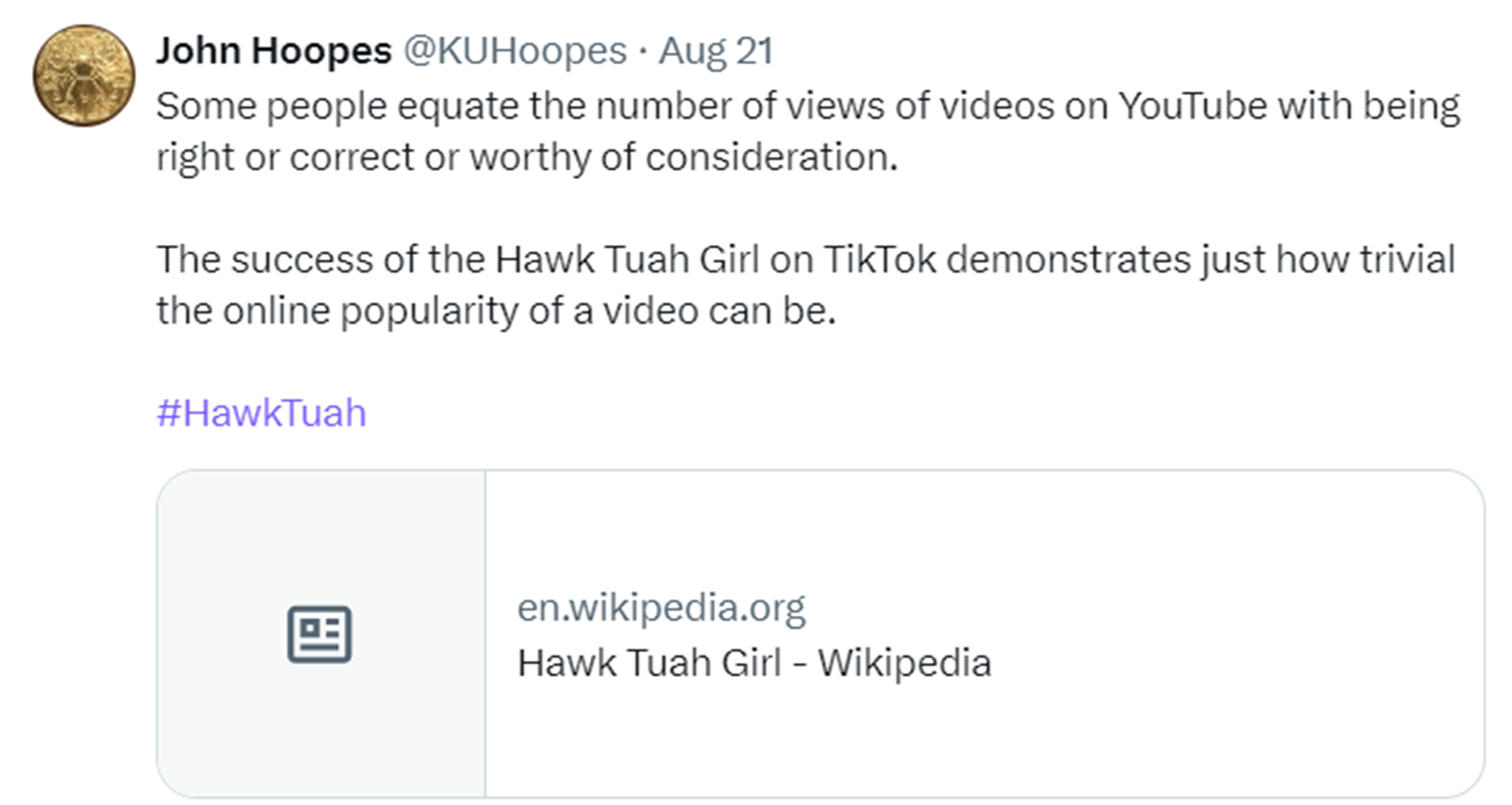
“Haliey Welch (/ˈheɪli/; born 2002), commonly known as Hawk Tuah Girl, is an American woman who gained notability from a viral video posted in 2024 where she used the catchphrase, “hawk tuah“, an apparent onomatopoeia for expectoration on a man’s penis during oral sex. On June 11, 2024, a man on the street YouTube channel, Tim & Dee TV, released a video featuring an interview with Haliey Welch in the Broadway district of Nashville, Tennessee. During the video, she was asked a series of not-safe-for-work questions including, “What’s one move in bed that makes a man go crazy every time?” Welch’s reply, using her Southern accent, was, “You gotta give ’em that ‘hawk tuah’ and spit on that thang,” referring to spitting on a man’s penis during oral sex. The original video went viral, receiving millions of views across TikTok and Instagram, spawning remixes and remakes of the original audio, and gaining Welch the nickname Hawk Tuah Girl. Wanting to capitalize on the viral video, she partnered with a local apparel brand to begin selling Hawk Tuah merchandise, selling over $65,000 worth of it within a couple of weeks. Because of her newfound internet fame, she quit her job at a mattress spring factory, in order to pursue other ventures in social media. On July 2, 2024, Welch signed for representation with The Penthouse. The same day, Welch launched Instagram and TikTok accounts, amassing over 100,000 followers on Instagram in the span of one day. The following day, July 3, she established her own company, 16 Minutes, whose name is a play on the phrase “15 minutes of fame“. Welch also filed for trademarks in apparel and entertainment for her catchphrase.” ref
Chrissy M. E. Hansen BLM @DepthsofTime97, “The Southern Poverty Law Center, which is the leading and foremost authority, literally names Hancock in an article dealing with how the far right and white supremacists use pseudo-archaeology and ancient aliens.”
Highlight: “Jackson knew this because the evidence was everywhere in plain sight. “In the monuments and fortifications of an unknown people, we behold the memorials of a once-powerful race,” said Jackson, “exterminated to make room for the existing savage tribes.” This reference to a “once-powerful race” was not lost on the American public of 1830. Every schoolboy and girl knew it to be the Lost Race of the Mound Builders, believed to be the continent’s original Caucasian inhabitants. From the colonial era into the twentieth century, it was widely accepted that certain earthen structures and burial grounds proved the existence of “white” or Indo-European peoples who settled North America only to be wiped out by the arrival of Jackson’s “savage (Asiatic) tribes.” As the country expanded west, the “Moundbuilders” myth had obvious utility: If the Indians destroyed earlier waves of (white) settlers, their own extermination was just another turn of history’s wheel. In the early 1890s, the U.S. ethnologist Cyrus Vance discredited the theory in a series published by the Smithsonian Institution. But the idea of a pre-Colombian “white genocide” never disappeared. It survived in subcultures, influenced by the occult and Atlantis legends, which clung to theories of lost ancient super-civilizations that, curiously, always seemed to be racially “white.” ref
Chapps @chapps, “Great in-depth article about the history of white supremacy, the alt-right, Nazism, and pseudo-archaeology.”
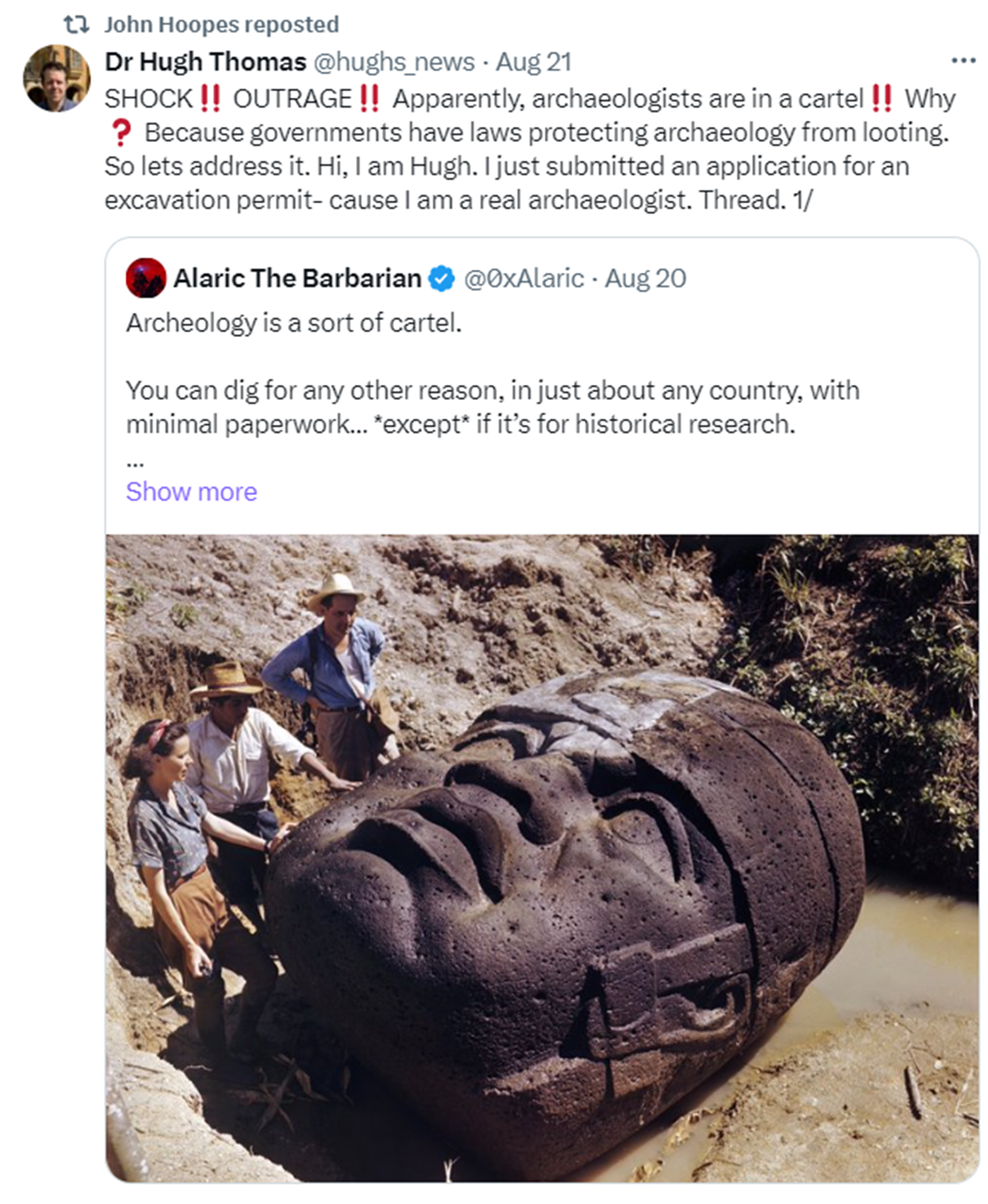
Dr Hugh Thomas @hughs_news, “SHOCK, OUTRAGE, Apparently, archaeologists are in a cartel. Why? Because governments have laws protecting archaeology from looting. So, let’s address it. Hi, I am Hugh. I just submitted an application for an excavation permit- because I am a real archaeologist. Ok, so this tweet thread is one of the more illogical I have read from pseudoarchs. Because it is effectively arguing that anyone should be allowed to dig any ancient site. No control. No permits. Just dig away! That is stupid! That is looting. The whole point of archaeological excavations is we dig in a controlled manner, recording everything. Because once it is excavated- that’s it. You can never put it back. Never recreate it. Nothing. Stuff it up and it’s very hard to un-stuff it. Now imagine allowing what this guy is saying. Any site, anywhere, can be excavated by whoever. Guess what, I think your grandmothers skeleton holds the key to Atlantis. I am digging it up. I am going to toss the bones away. I am going to take the jewelry. Done!”
Dr Hugh Thomas @hughs_news , “That is why permits exist. An agency who runs this system can set rules: where you can dig, where the material goes, how it is excavated, how it is reported etc. To make sure information is recorded and shared. To stop people with like Alaric ripping tombs to shreds on a hunch. I mean some of old mates tweets are flat wrong. Egypt brought in an early permit system- to stop looting of artefacts- in 1835. The Egyptian Agency that protects sites was set up in the 1850s. The Greeks had permits by the 1930s. Why- to stop people destroying archaeology. BUT SCHLIEMANN! How would he have ever found Troy! First, people worked at the site before Schliemann. Secondly- HE BLOODY DESTROYED THAT SITE! He excavated a huge trench through the middle of it, some say he used dynamite. He threw away material because it “wasn’t old enough.”
Dr Hugh Thomas @hughs_news , “Troy is a mess. He treasure hunted gold, and then smuggled it out of the country. Where is ‘Priam’s treasure’? Not in Turkey. To use him as your shining bastion of pseudo-archaeology shows how little you know about archaeology. But by issuing permits, the government CONTROLS ME! That is utter nonsense. Let’s say I found Atlantis in Greece. Are you honestly telling me that they would hide one of the most significant archaeological discoveries because they are like ‘Nah bro’. Just to state, at the end of a project I will submit reports. I also send our academic articles to them too- so they have a copy of what is found in their own lands. But not once have I been told- “You are not able to publish that. Because… like… WEF says no!”
Dr Hugh Thomas @hughs_news , “But this old mate saved the silliest tweet till the end. He wants Trump to open up national archives etc. so what- you can just look at stuff in museums. But what does that even get you… most museums house their entire collection online anyway… unless they are WEF MUSEUMS!! And he wants Trump to pressure Brazil to let ‘eccentrics’ excavate ‘the Amazon’-a forest. Apart from this leading to looting I wouldn’t trust Trump to do this… wanna know why, EXPLOSIVE NEWS, TRUMP IS THE WORLD ECONOMIC FORUM, @BrightInsight6 does Trump control Gobekli? Jokes on turnip aside- we have rules and regulations for all parts of our lives. Archaeology is destructive. It needs to be done correctly. Governments also want to limit looting and the loss of their cultural heritage. Random people digging loses us historical knowledge. I know people want more answers to ancient mysteries. Me too! That’s why I am in this job! But rushing means we can’t do cool science like this: Link . I hope this helps some people understand why this was such a silly thread. Happy to answer questions. Slight correction- a small bit of Priam’s treasure is in Turkey… because Schliemann used it to bribe himself back into Turkey. Cool, hero guys….”
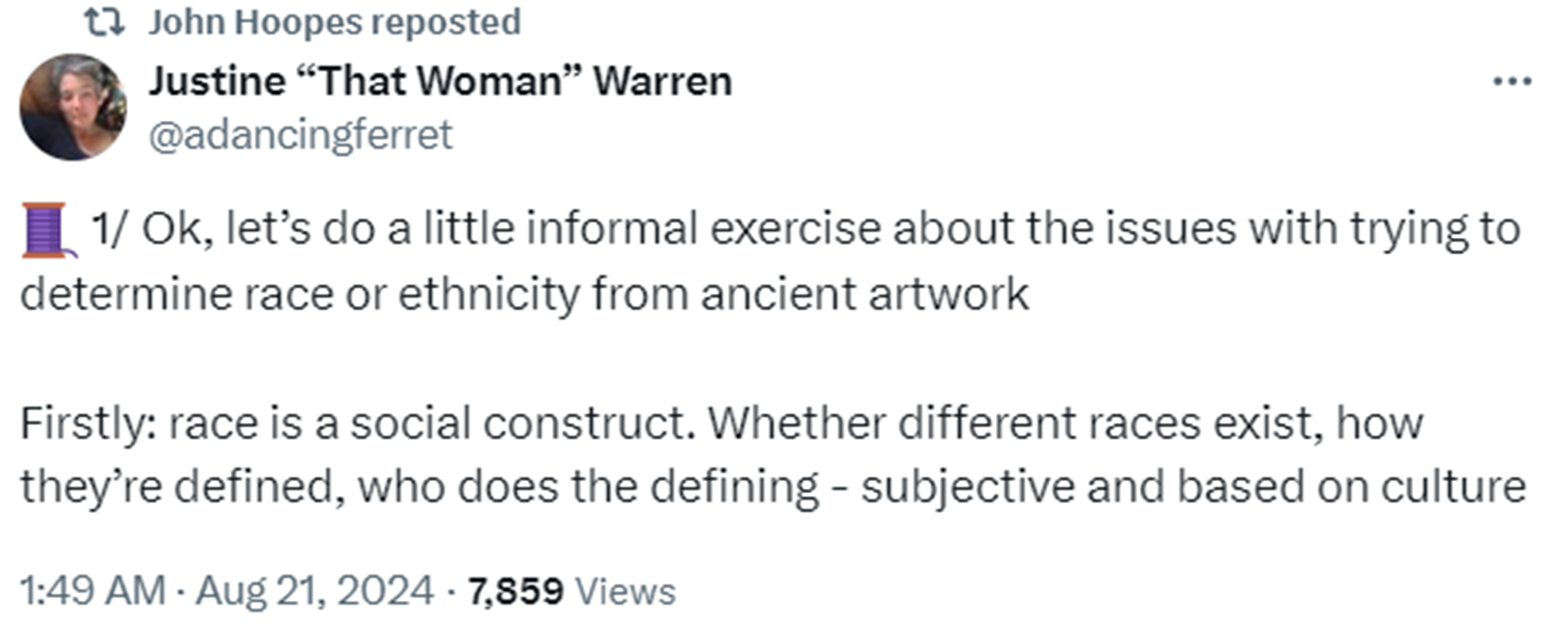
Justine “That Woman” Warren @adancingferret, “Ok, let’s do a little informal exercise about the issues with trying to determine race or ethnicity from ancient artwork Firstly: race is a social construct. Whether different races exist, how they’re defined, who does the defining – subjective and based on culture and our modern western categories are anachronistic when applied to the past. In other words, the physical features we tend to use to decide what race someone is when we look at them are not necessarily relevant when looking at ancient art. Plus they’re not always consistent skin tone, hair color and type, eye shape and color, nose shapes, lips, etc. vary. A lot. And identifications based on those features can get very fuzzy from personal to person. And those outward features or phenotype our interpretations of them don’t always match what looking at their genes (genotype) may tell us about ancestry, geographic origins, etc. Or even how they were identified themselves or were identified by others in their daily lives and cultural contexts. On top of that, art, and ancient art is included in this, isn’t always a super-accurate or portrait-like depiction of people as broad groups or individuals. So, for example, Egyptian art has what’s called a “canon.” Basically, the standard ways things are depicted that are consistent.”
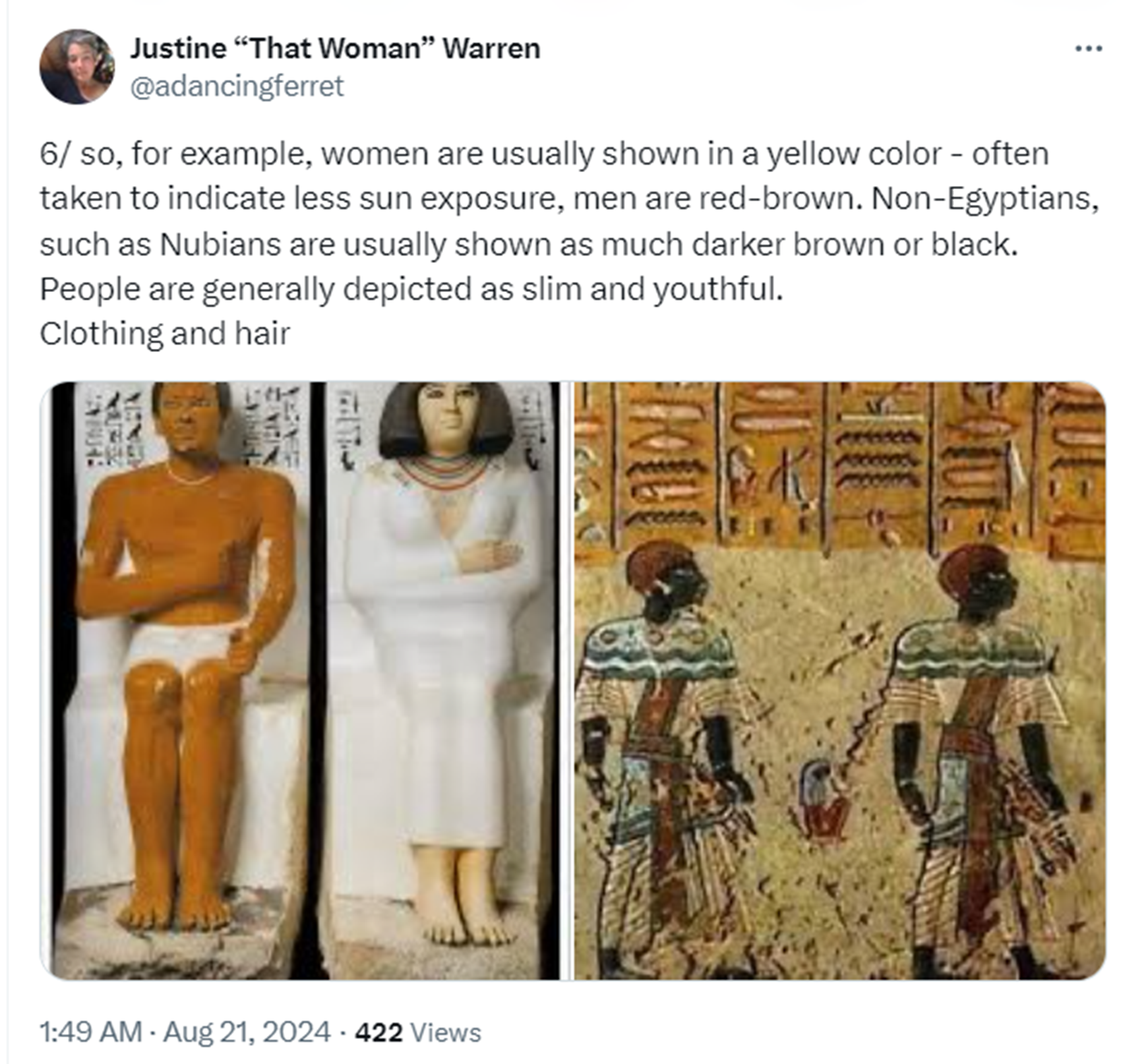
Justine “That Woman” Warren @adancingferret, “So, for example, women are usually shown in a yellow color – often taken to indicate less sun exposure, men are red-brown. Non-Egyptians, such as Nubians are usually shown as much darker brown or black. People are generally depicted as slim and youthful. Clothing and hair is usually a kilt or long robe for men, a shift dress for women. Foreigners are usually shown in elaborate and distinct hair styles and clothing – feathers in headbands, animal skins, brightly colored clothing, full beards or braided hair, etc. depending on where they’re from there’s more to it than just that, but that’s enough for now. In part, these kind of stereotyped images are like this because Egyptian art wasn’t intended as decorative. It had functions as a way of representing ideal reality and as magical/religious imagery. If individuals and their unique identities were important, they could be indicated using names and titles. So, that brings us to the exercise. I’m going to post two images next. Based on this crash course in Egyptian art canons, do you think you’re looking at a Nubian or an Egyptian?”
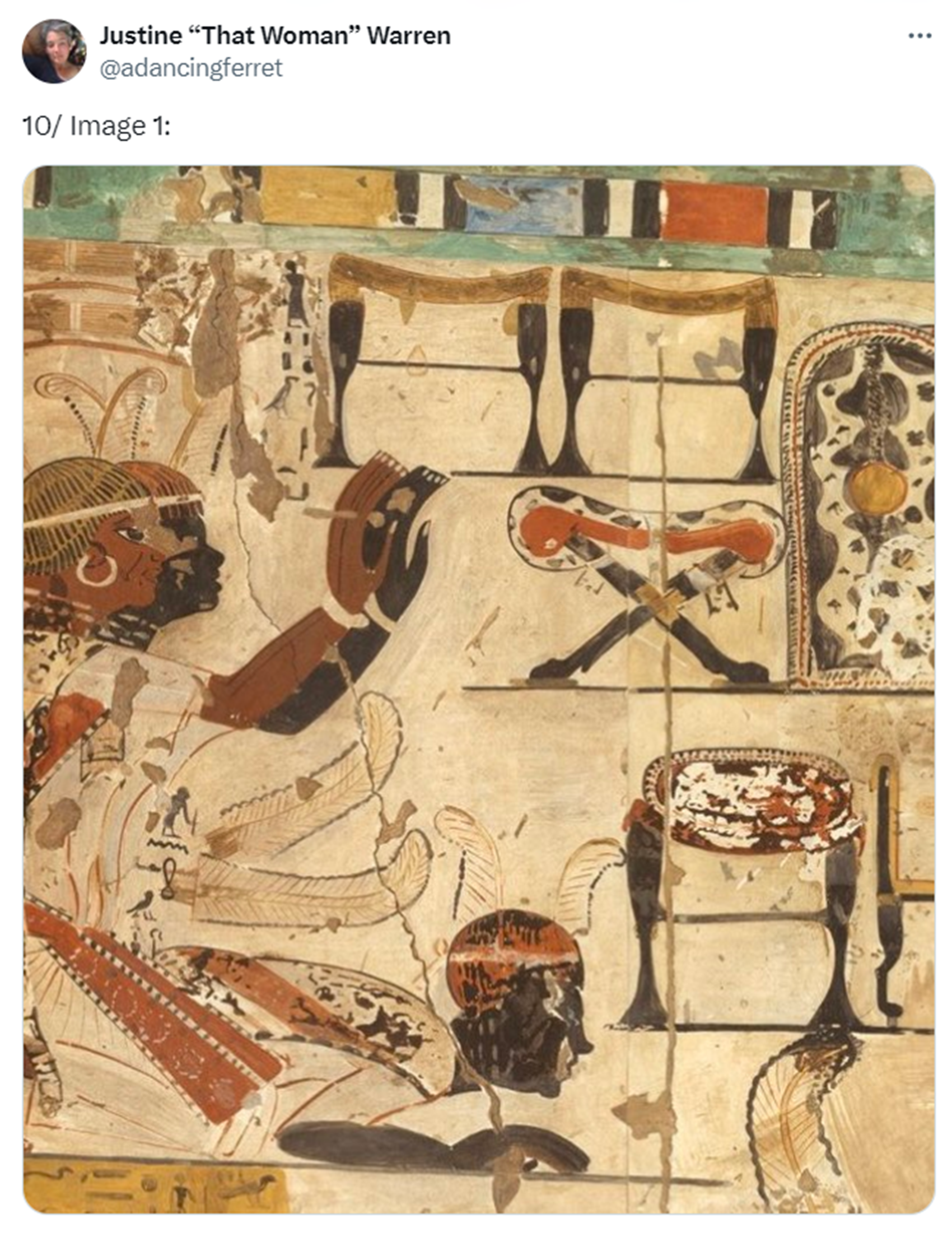
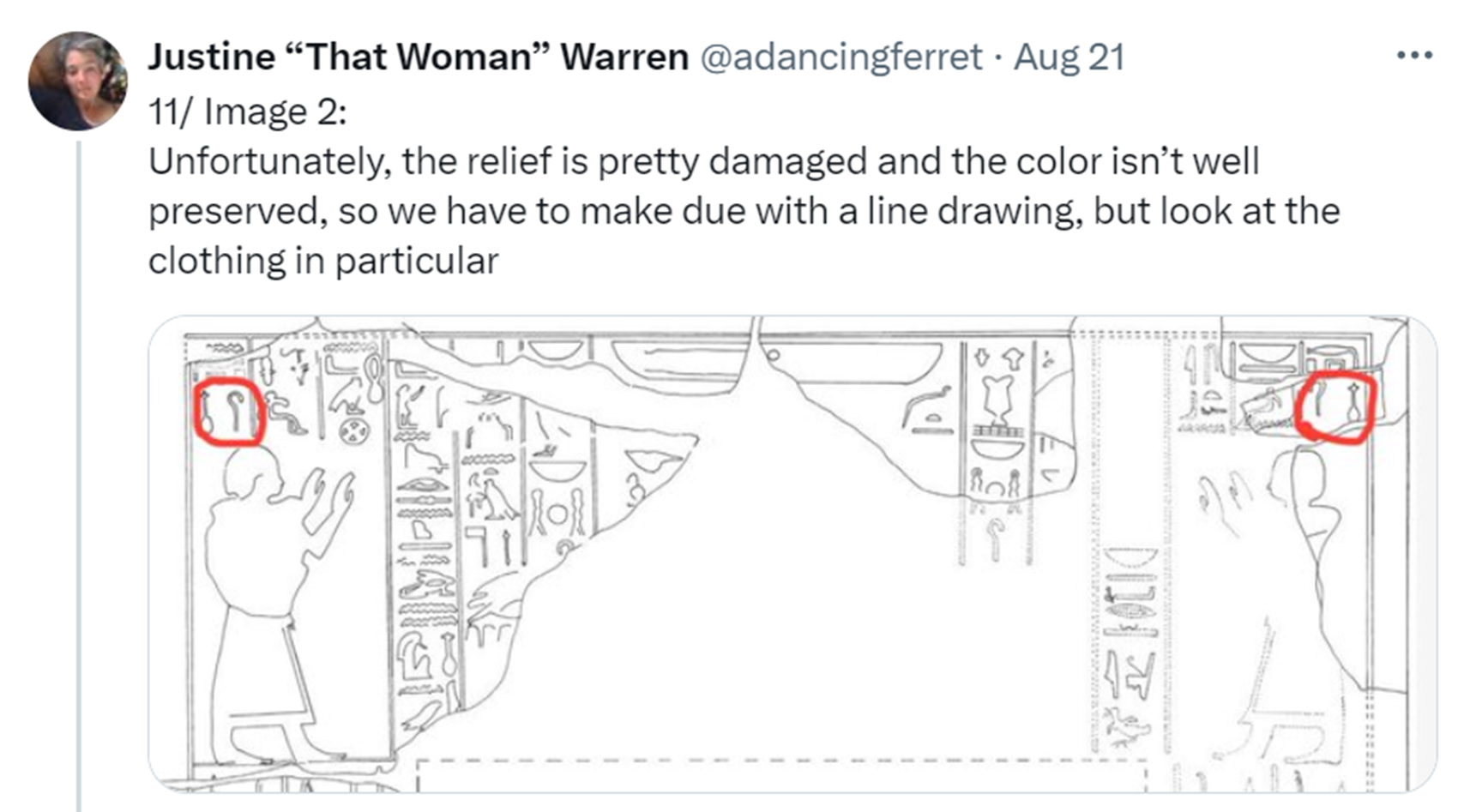
Justine “That Woman” Warren @adancingferret, “Image 1: shows your pretty typical depictions of Nubians – very dark or black skin, feathers in headbands, some colorful sashes, etc. Image 2: shows a pretty standard depiction of an Egyptian man, no special headgear, a long, plain robe. Would you believe you’re looking at the same guy in both images? Because you are. He’s a Nubian official named Hekanefer who was Chief of Miam – a region of Nubia – during the reign of Tutankhamun in the 18th Dynasty.”
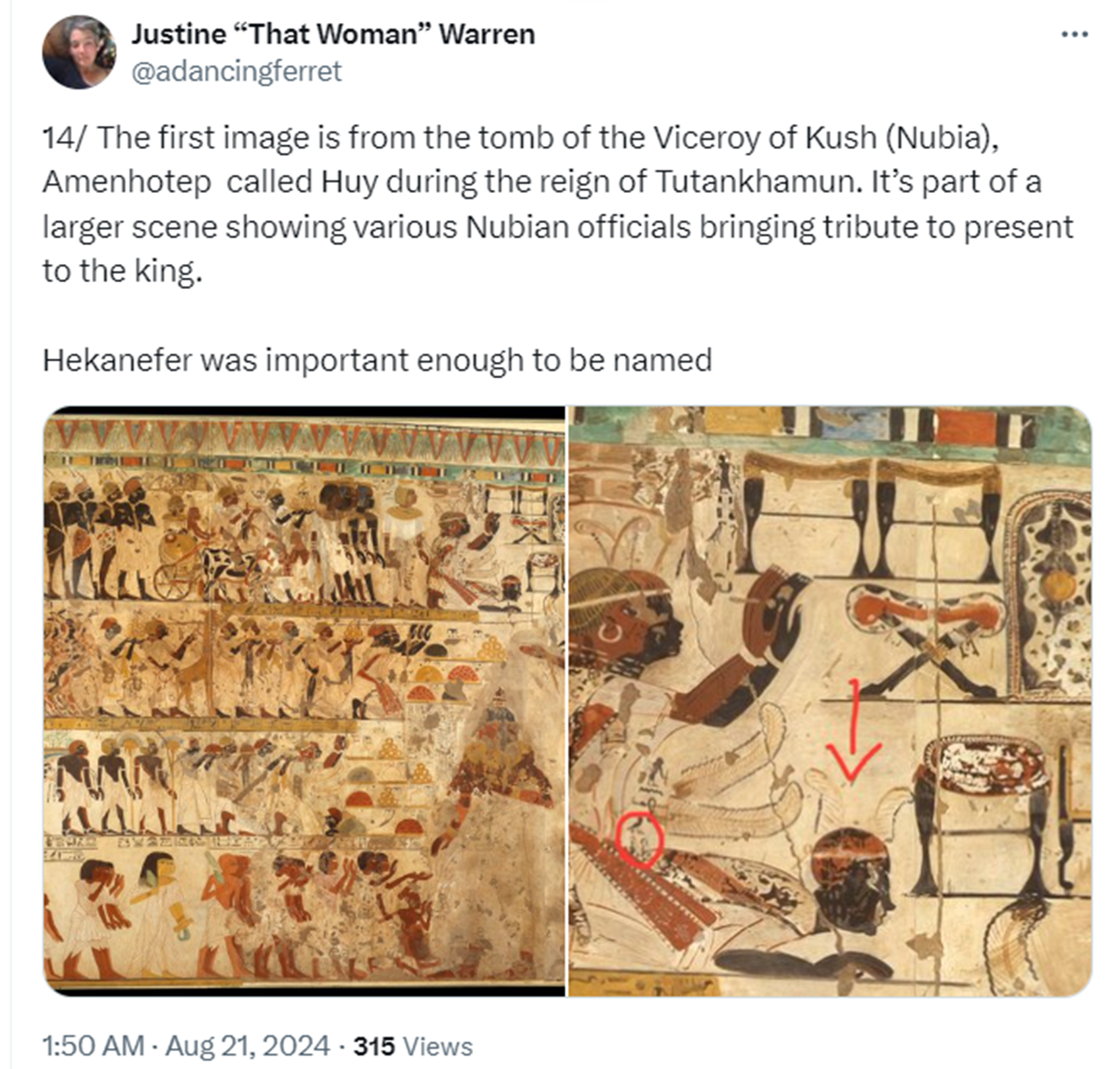
Justine “That Woman” Warren @adancingferret, “The first image is from the tomb of the Viceroy of Kush (Nubia), Amenhotep called Huy during the reign of Tutankhamun. It’s part of a larger scene showing various Nubian officials bringing tribute to present to the king. Hekanefer was important enough to be named.”

Justine “That Woman” Warren @adancingferret, “The second image comes from the lintels at the entrance of the tomb Hekanefer built for himself in his home in Nubia at a site called Toshka. The tomb looks VERY Egyptian. The layout even resembles the tomb of Viceroy Huy in Egypt I’ve circled his name as I did above.”
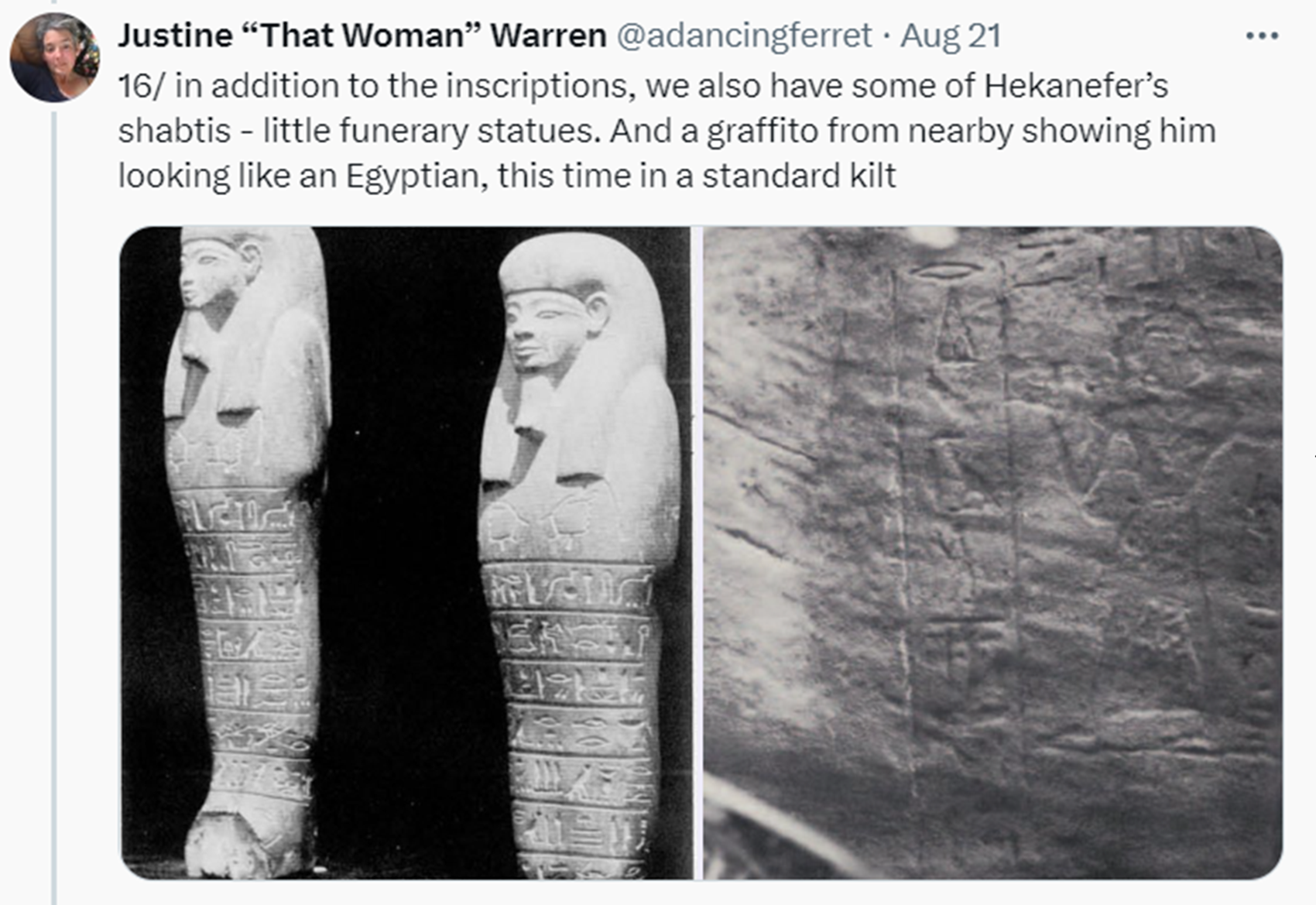
Justine “That Woman” Warren @adancingferret, “In addition to the inscriptions, we also have some of Hekanefer’s shabtis – little funerary statues. And a graffito from nearby showing him looking like an Egyptian, this time in a standard kilt. So: which image and identity of Hekanefer is the “truth” or the most accurate? The stereotypical Nubian one in the tomb of an Egyptian in Egypt? Or the stereotypical Egyptian one in his own tomb in Nubia?”
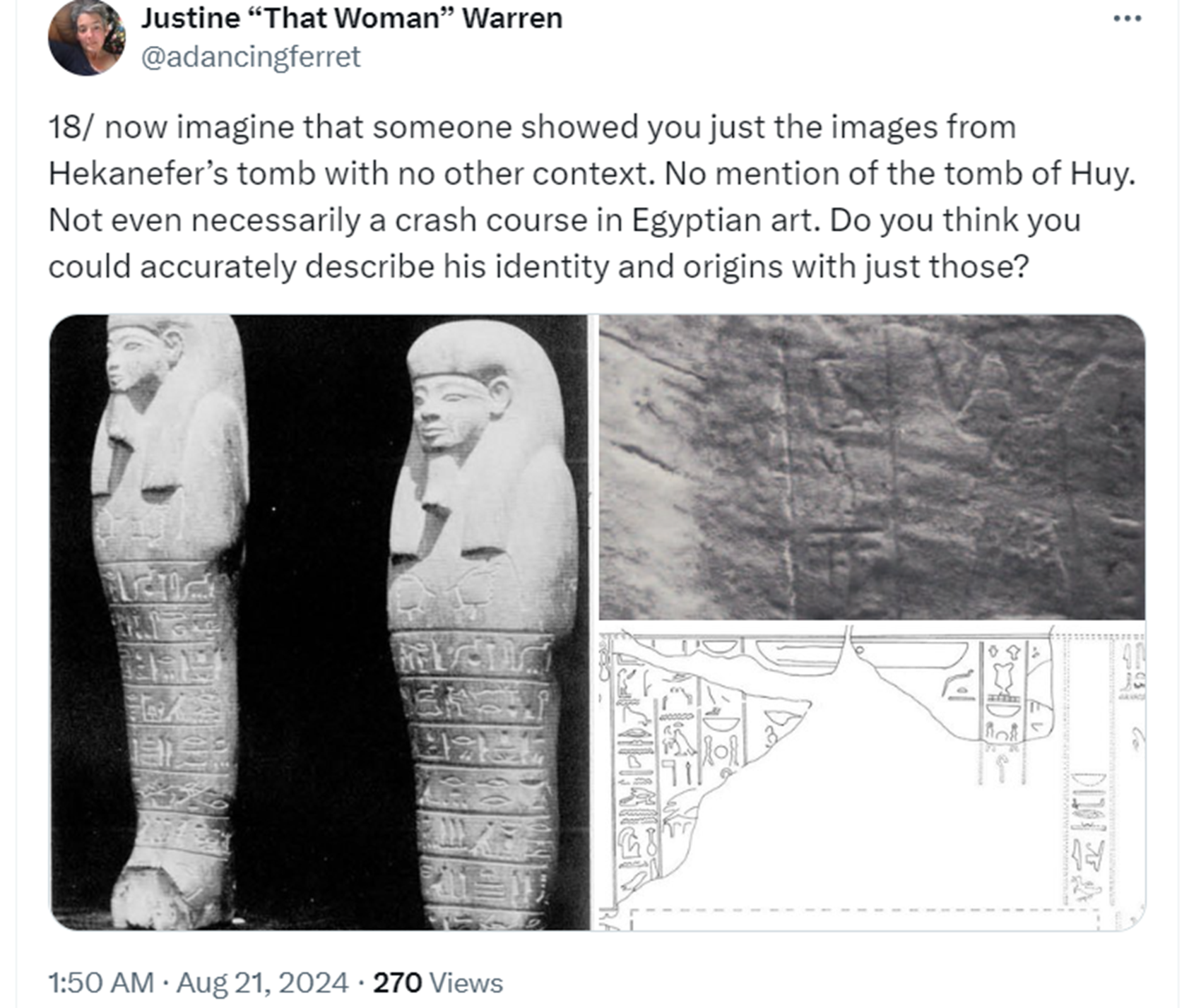
Justine “That Woman” Warren @adancingferret, “Now imagine that someone showed you just the images from Hekanefer’s tomb with no other context. No mention of the tomb of Huy. Not even necessarily a crash course in Egyptian art. Do you think you could accurately describe his identity and origins with just those? Or, for that matter, if I just showed you the statues of Rahotep and Nofret, would you think most Egyptian men looked like Clark Gable overdosed on bronzer and the women had a touch of jaundice or used way too much banana setting powder? Or that this indicates their genetic makeup and ancestry? Because that’s the kind of thing Hancock among others tends to do when looking at ancient art and deciding some people look “African” or “Caucasian” or “Asian” (though he sometimes used a term starting with M that gets posts flagged). While we’re at it – every Egyptian and Nubian I’ve shown here is African. Do they all look alike? Do they represent the wide variety of appearances of people in Africa? Do you think making assumptions about “visitors” based on them is a good idea? While we’re at it – every Egyptian and Nubian I’ve shown here is African. Do they all look alike? Do they represent the wide variety of appearances of people in Africa? Do you think making assumptions about “visitors” based on them is a good idea? Think about it…”
Glen Parry @glenparry8183 , “Note that, there is an almost reverse angle to this position, whereby, the modern Egyptians are the descendants of less civilized Persians, Greeks, Romans, and Arabs, who wiped out the entire ancient population of Egypt, and thus have no connection the land or its history. The, long discarded, Dynastic/Civilizing Race Theory, turned on its head, to give us an Anti-Civilizing Race Theory; it’s often used to deny the African origins of the entire population of North Africa. These days, the only people not allowed to be Egyptian are the Egyptians. I think some of that is down to foreigners, mainly from your side of the pond, denying the Egyptians their place in the continent; though there is also the cultural influence, that’s always been there, which seems to drag Egypt to see its place as being in the wider Middle East.”
Justine “That Woman” Warren @adancingferret, “Exactly, plus the tension in modern Egypt identifying with Africa and Africans, especially sub-Saharan Africa and Africans. The issues of colorism and bias against Nubians, southern Egyptians, and sub-Saharan Africans has been part of ethnographic and sociological and political discussion for some time. Especially since the relocation for the Aswan Dam. Within academia, it’s a perpetual issue of extremes sometimes either to force Egypt into the Middle East or into just Africa. Plus, the racial debates. And the residue of Dynastic Race theory and colonialism.”
Glen Parry @glenparry8183 , “They’re also starting to clamp down on pseudo-archaeologists going over there, & telling both tour groups & the Egyptians, that it wasn’t the ancestors of the modern Egyptians did this, but someone else. (First the Egyptians were too brown, for some, now they’re not brown enough).”
Whitewashing Pseudoarchaeology
“For those of you tired of reading my take on pseudoarchaeology, you maybe should sit this blog post out. There’s not much new here. Another Flint Dibble twitter thread has prompted this post and I want to stress from the top that Flint is not wrong and his heart and his mind is in the right place. He is doing the best he can and clearly understands his audience of fellow travelers. My post today isn’t meant to criticize him or even the larger “myth buster” crowd who loves to go after pseudoarchaeology whenever it rears its fugly head on social media or on some or another cable TV network.” ref
“Instead, I want to offer another take on things (and this take doesn’t deviate much from my other takes (pdf), but to be fair neither does Flint’s nor his allies’). I’m increasingly concerned that the whitewashing of pseudoarchaeology by its critics poses certain risks.” ref
“First, many of the most open critics of pseudoarchaeology associate this pseudodiscipline with guys like Erich von Däniken and various cable TV celebrities who offer variations on the same argument: we don’t understand everything about the past and that leaves open the door to the possibility that … it was aliens. These aliens did everything from build monumental architecture to position themselves as gods or introduce science and technology that exceeds what we have today. It doesn’t really matter whether there are simpler or better or more scientifical explanations for the “mysteries” that pseudoarchaeologists pose. What matters is that their sensational solutions seem to tie together various purportedly loose threads and offer an alternative explanation to the past. It also matters that “real archaeologists hate these guys” which contributes to the credibility of pseudoarchaeology especially among folks who are skeptical of academics and other supposed experts. This is obviously only the tip of the iceberg, though, and there’s a thriving cottage industry on the web for various theories.” ref
“Folks inclined to challenge pseudoarchaeologists tend to pick their arguments apart, demonstrate how mysterious situations aren’t very mysterious, and offer more plausible alternatives to ancient aliens or whatever. The best combatants in the war against pseudoarchaeology go a step further and demonstrate how many pseudoarchaeologists grounded their arguments in assumptions that ancient folks – especially those in Africa, Meso-America, and the Middle East – couldn’t build impressive monuments or develop impressive tools and technologies on their own. The implication here being that these communities and societies were simply too primitive prior to the arrival of advanced Europeans (and colonialism). Locally, artifacts such as the Kensington Runestone (which attracted the attention of Theodore Blegen of the famous, archaeologically inclined Blegen clan. For the record, Theodore Blegen considered the runestone a modern forgery) continue to bolster false claims of Viking exploration and even settlement in Minnesota as a counter weight to Native American claims.” ref
“These assumptions and arguments, no matter how strained or systematically debunked, make pseudoarchaeology appealing to white supremacists and others who favor historical narratives that promote European superiority. If there is a front that has real value in the pseudoarchaeology wars, it is this front, and Dibble and the “myth buster” crowd has done important work to make visible the link between certain contemporary strands of pseudoarchaeology and far right political ideologues.” ref
“Unfortunately, this is also where things get complicated. There seems to be this assumption that because white supremacists appreciate and have even developed pseudoarchaeology now, pseudoarchaeology itself is racist or has its origins in racist ways of seeing the world. To make this argument effectively, archaeologists in the pseudoarchaeology wars tend to whitewash pseudoarchaeology by emphasizing its white, European practitioners (especially its roots in Nazism), and this coincides well what we see on TV and the popularity of von Däniken’s best selling books. There is no doubt that today pseudoarchaeology can represent a gateway drug for disaffected individuals who are skeptical of experts, the academy, and broader trends in society.” ref
“The only problem is that this whitewashing, as most whitewashing, isn’t entirely true. In fact, pseudoarchaeology has roots that go much deeper than the mid-20th century and stretch far wider than Nazism, obscure Swiss writers, cable TV hosts, and disturbing corners of the contemporary web. In fact, pseudoarchaeology has roots in the 19th century where visions of the Wheel of Ezekiel, to use an example explored by Michael Lieb, found powerful purchase in Black American spirituality. While 19th century ecstatic visionaries didn’t assume the wheel to be ancient aliens, the mystical and supernatural power of this vision resonated well into the 20th century where it may have influenced Sun Ra’s abduction narrative, Elijah Muhammed’s notion of the Mother Plane or Mother Wheel, as well as some of von Daniken’s alien visitors. It would seem that visions of alien visitors are not simply a white thing.” ref
“Overlooking these influential narratives (and I promised myself that I would not go on about Sun Ra in this post), is part of a larger pattern of whitewashing the rise of interest in pseudoarchaeology which is often seen as part of the growing popularity of the far right political movements.” ref
“It is rare, for example, to see archaeologists connect the growing interest in pseudoarchaeology with the resurgence of interest in Afrofuturism, of example. In many ways, the emancipatory potential of the Black Panther’s Wakanda or the remarkable Afrofuturist narratives spun by Octavia Butler and Samuel Delany challenge the traditional view of history and archaeology. On the one hand, it is easy to overlook the narratives embodied in this work as fiction, but, on the other hand, stories like the Black Panther leverage narrative strategies with clear parallel to those present in pseudoarchaeology: there is a mysterious country, in Africa, that somehow escaped notice from not only colonial powers in their rush to empire, but also generations of historians, archaeologists, and anthropologists!! Once again, white European archaeologists miss what must have been right before their eyes. More importantly, these works complicate traditional narratives of progress upon which certain forms of archaeological thinking rest, by positing technologically, socially, and materially advanced pasts and futures.” ref
“In the hands of Black authors, pseudoarchaeology in both fiction and non-fiction works, supported anti-colonial and anti-racist narratives. It bolstered problematic, but nevertheless important narratives associated with Afrocentrism and contributed to new forms of spirituality and religion that adapted older practices and beliefs to the modern age. Pseudoarchaeology is powerful (and potentially dangerous) because it subverts academic knowledge, narratives of progress, and associated claims to authority. In the hands of Black authors, pseudoarchaeology, Afrocentrism, and Afrofuturism became weapons of the weak. Pseudoarchaeology appeared in popular literature, was celebrated in popular music, and circulated in served urban communities where it had the capacity to create countercultural spaces that challenged the knowledge of experts and institutions to which few Blacks had ready access.” ref
“Reciting this argument is tedious (and I do it more length elsewhere), but important. It is important because it reminds us to take pseudoarchaeology seriously as a subversive narrative. Flint and the “myth busters” get this right and the threat of subverting the institutional power of “real” archaeology. It is important because it reminds us that pseudoarchaeology, despite being used by white supremacist, is not exclusive to white people. In fact, I would argue that it didn’t develop exclusively in a white context. In other words, white supremacists are using a narrative with roots in Black traditions. To my mind, this is a powerful fuck you to white supremacists…” ref
“It is important, then, to remain attentive and critical of narratives and arguments that seek to whitewash pseudoarchaeology. The tendency to whitewash pseudoarchaeology appears to be effectively parallel to the tendency to whitewash archaeology in general. It remains only too common to exclude, to marginalize, to “other,” and to ignore non-white narratives whether rooted in popular knowledge, pseudoarchaeology, or indigenous perspectives on the past.” ref
“Finally, it is important to work to elevate these perspectives to greater prominence in discussions of pseudoarchaeology and to temper our tendency to see the subversive potential of pseudoarchaeology as a threat to institutional archaeology, “science,” or the established narratives. This means being aware that archaeologists have a long tradition of using practices like “myth busting” (under its various guises) and “science” to suppress diverse ways of viewing the past as well as the communities that hold them. To be clear, no one is shedding a tear for the “it’s aliens” guy or white supremacists, but pseudoarchaeology is not simple and there are wheels within wheels (Ezekiel 1:16).” ref
- Addressing Graham Hancock the Pseudoarchaeological Theorist, as well as Flaws in his Ancient Apocalypse, Great flood, and Seafaring R1b
- John Hoopes (Department of Anthropology, University of Kansas), who Graham Hancock thinks is “the most vehement and insulting of all archaeologists” and I think is great, addresses Pseudoarchaeology, Pseudohistory, and Pseudoscience
- Addressing Pseudoarchaeology, Pseudohistory, Pseudojournalism, Pseudoscholarship, and Pseudoscience
- Digging Up Ancient Aliens, by Archaeologist Fredrik Trusohamn, uses a background in Archaeology to examine Ancient Aliens and Pseudo-History
- Archaeology Tube by Dr. Bill Farley addressing Real Archaeology and Pseudoarchaeology as well as Science Communication with the Public
- Alice Beck Kehoe: Feminist Anthropologist and Archaeologist, Addressing Sexism, Racism, Ethnocentrism, and Shamanism
- Jeffrey (JT) Lewis is a southeastern archaeologist and Ph.D. Grad Student who makes archaeology YouTube videos

People don’t commonly teach religious history, even that of their own claimed religion. No, rather they teach a limited “pro their religion” history of their religion from a religious perspective favorable to the religion of choice.

Do you truly think “Religious Belief” is only a matter of some personal choice?
Do you not see how coercive one’s world of choice is limited to the obvious hereditary belief, in most religious choices available to the child of religious parents or caregivers? Religion is more commonly like a family, culture, society, etc. available belief that limits the belief choices of the child and that is when “Religious Belief” is not only a matter of some personal choice and when it becomes hereditary faith, not because of the quality of its alleged facts or proposed truths but because everyone else important to the child believes similarly so they do as well simply mimicking authority beliefs handed to them. Because children are raised in religion rather than being presented all possible choices but rather one limited dogmatic brand of “Religious Belief” where children only have a choice of following the belief as instructed, and then personally claim the faith hereditary belief seen in the confirming to the belief they have held themselves all their lives. This is obvious in statements asked and answered by children claiming a faith they barely understand but they do understand that their family believes “this or that” faith, so they feel obligated to believe it too. While I do agree that “Religious Belief” should only be a matter of some personal choice, it rarely is… End Hereditary Religion!

Animism: Respecting the Living World by Graham Harvey
“How have human cultures engaged with and thought about animals, plants, rocks, clouds, and other elements in their natural surroundings? Do animals and other natural objects have a spirit or soul? What is their relationship to humans? In this new study, Graham Harvey explores current and past animistic beliefs and practices of Native Americans, Maori, Aboriginal Australians, and eco-pagans. He considers the varieties of animism found in these cultures as well as their shared desire to live respectfully within larger natural communities. Drawing on his extensive casework, Harvey also considers the linguistic, performative, ecological, and activist implications of these different animisms.” ref

We are like believing machines we vacuum up ideas, like Velcro sticks to almost everything. We accumulate beliefs that we allow to negatively influence our lives, often without realizing it. Our willingness must be to alter skewed beliefs that impend our balance or reason, which allows us to achieve new positive thinking and accurate outcomes.

My thoughts on Religion Evolution with external links for more info:
- (Pre-Animism Africa mainly, but also Europe, and Asia at least 300,000 years ago), (Pre-Animism – Oxford Dictionaries)
- (Animism Africa around 100,000 years ago), (Animism – Britannica.com)
- (Totemism Europe around 50,000 years ago), (Totemism – Anthropology)
- (Shamanism Siberia around 30,000 years ago), (Shamanism – Britannica.com)
- (Paganism Turkey around 12,000 years ago), (Paganism – BBC Religion)
- (Progressed Organized Religion “Institutional Religion” Egypt around 5,000 years ago), (Ancient Egyptian Religion – Britannica.com)
- (CURRENT “World” RELIGIONS after 4,000 years ago) (Origin of Major Religions – Sacred Texts)
- (Early Atheistic Doubting at least by 2,600 years ago) (History of Atheism – Wikipedia)
“Religion is an Evolved Product” and Yes, Religion is Like Fear Given Wings…
Atheists talk about gods and religions for the same reason doctors talk about cancer, they are looking for a cure, or a firefighter talks about fires because they burn people and they care to stop them. We atheists too often feel a need to help the victims of mental slavery, held in the bondage that is the false beliefs of gods and the conspiracy theories of reality found in religions.
Understanding Religion Evolution:
- Pre-Animism (at least 300,000 years ago)
- Animism (Africa: 100,000 years ago)
- Totemism (Europe: 50,000 years ago)
- Shamanism (Siberia: 30,000 years ago)
- Paganism (Turkey: 12,000 years ago)
- Progressed organized religion (Egypt: 5,000 years ago), (Egypt, the First Dynasty 5,150 years ago)
- CURRENT “World” RELIGIONS (after 4,000 years ago)
- Early Atheistic Doubting (at least by 2,600 years ago)
“An Archaeological/Anthropological Understanding of Religion Evolution”
It seems ancient peoples had to survived amazing threats in a “dangerous universe (by superstition perceived as good and evil),” and human “immorality or imperfection of the soul” which was thought to affect the still living, leading to ancestor worship. This ancestor worship presumably led to the belief in supernatural beings, and then some of these were turned into the belief in gods. This feeble myth called gods were just a human conceived “made from nothing into something over and over, changing, again and again, taking on more as they evolve, all the while they are thought to be special,” but it is just supernatural animistic spirit-belief perceived as sacred.
Quick Evolution of Religion?
Pre-Animism (at least 300,000 years ago) pre-religion is a beginning that evolves into later Animism. So, Religion as we think of it, to me, all starts in a general way with Animism (Africa: 100,000 years ago) (theoretical belief in supernatural powers/spirits), then this is physically expressed in or with Totemism (Europe: 50,000 years ago) (theoretical belief in mythical relationship with powers/spirits through a totem item), which then enlists a full-time specific person to do this worship and believed interacting Shamanism (Siberia/Russia: 30,000 years ago) (theoretical belief in access and influence with spirits through ritual), and then there is the further employment of myths and gods added to all the above giving you Paganism (Turkey: 12,000 years ago) (often a lot more nature-based than most current top world religions, thus hinting to their close link to more ancient religious thinking it stems from). My hypothesis is expressed with an explanation of the building of a theatrical house (modern religions development). Progressed organized religion (Egypt: 5,000 years ago) with CURRENT “World” RELIGIONS (after 4,000 years ago).
Historically, in large city-state societies (such as Egypt or Iraq) starting around 5,000 years ago culminated to make religion something kind of new, a sociocultural-governmental-religious monarchy, where all or at least many of the people of such large city-state societies seem familiar with and committed to the existence of “religion” as the integrated life identity package of control dynamics with a fixed closed magical doctrine, but this juggernaut integrated religion identity package of Dogmatic-Propaganda certainly did not exist or if developed to an extent it was highly limited in most smaller prehistoric societies as they seem to lack most of the strong control dynamics with a fixed closed magical doctrine (magical beliefs could be at times be added or removed). Many people just want to see developed religious dynamics everywhere even if it is not. Instead, all that is found is largely fragments until the domestication of religion.
Religions, as we think of them today, are a new fad, even if they go back to around 6,000 years in the timeline of human existence, this amounts to almost nothing when seen in the long slow evolution of religion at least around 70,000 years ago with one of the oldest ritual worship. Stone Snake of South Africa: “first human worship” 70,000 years ago. This message of how religion and gods among them are clearly a man-made thing that was developed slowly as it was invented and then implemented peace by peace discrediting them all. Which seems to be a simple point some are just not grasping how devastating to any claims of truth when we can see the lie clearly in the archeological sites.
I wish people fought as hard for the actual values as they fight for the group/clan names political or otherwise they think support values. Every amount spent on war is theft to children in need of food or the homeless kept from shelter.
Here are several of my blog posts on history:
- To Find Truth You Must First Look
- (Magdalenian/Iberomaurusian) Connections to the First Paganists of the early Neolithic Near East Dating from around 17,000 to 12,000 Years Ago
- Natufians: an Ancient People at the Origins of Agriculture and Sedentary Life
- Possible Clan Leader/Special “MALE” Ancestor Totem Poles At Least 13,500 years ago?
- Jewish People with DNA at least 13,200 years old, Judaism, and the Origins of Some of its Ideas
- Baltic Reindeer Hunters: Swiderian, Lyngby, Ahrensburgian, and Krasnosillya cultures 12,020 to 11,020 years ago are evidence of powerful migratory waves during the last 13,000 years and a genetic link to Saami and the Finno-Ugric peoples.
- The Rise of Inequality: patriarchy and state hierarchy inequality
- Fertile Crescent 12,500 – 9,500 Years Ago: fertility and death cult belief system?
- 12,400 – 11,700 Years Ago – Kortik Tepe (Turkey) Pre/early-Agriculture Cultic Ritualism
- Ritualistic Bird Symbolism at Gobekli Tepe and its “Ancestor Cult”
- Male-Homosexual (female-like) / Trans-woman (female) Seated Figurine from Gobekli Tepe
- Could a 12,000-year-old Bull Geoglyph at Göbekli Tepe relate to older Bull and Female Art 25,000 years ago and Later Goddess and the Bull cults like Catal Huyuk?
- Sedentism and the Creation of goddesses around 12,000 years ago as well as male gods after 7,000 years ago.
- Alcohol, where Agriculture and Religion Become one? Such as Gobekli Tepe’s Ritualistic use of Grain as Food and Ritual Drink
- Neolithic Ritual Sites with T-Pillars and other Cultic Pillars
- Paganism: Goddesses around 12,000 years ago then Male Gods after 7,000 years ago
- First Patriarchy: Split of Women’s Status around 12,000 years ago & First Hierarchy: fall of Women’s Status around 5,000 years ago.
- Natufians: an Ancient People at the Origins of Agriculture and Sedentary Life
- J DNA and the Spread of Agricultural Religion (paganism)
- Paganism: an approximately 12,000-year-old belief system
- Paganism 12,000 years old: related to “Anarchism and Socialism” (Pre-Capitalism)
- Shaman burial in Israel 12,000 years ago and the Shamanism Phenomena
- Need to Mythicized: gods and goddesses
- 12,000 – 7,000 Years Ago – Paleo-Indian Culture (The Americas)
- 12,000 – 2,000 Years Ago – Indigenous-Scandinavians (Nordic)
- Norse did not wear helmets with horns?
- Pre-Pottery Neolithic Skull Cult around 11,500 to 8,400 Years Ago?
- 10,400 – 10,100 Years Ago, in Turkey the Nevail Cori Religious Settlement
- 9,000-6,500 Years Old Submerged Pre-Pottery/Pottery Neolithic Ritual Settlements off Israel’s Coast
- Catal Huyuk “first religious designed city” around 9,500 to 7,700 years ago (Turkey)
- Cultic Hunting at Catal Huyuk “first religious designed city”
- Special Items and Art as well as Special Elite Burials at Catal Huyuk
- New Rituals and Violence with the appearance of Pottery and People?
- Haplogroup N and its related Uralic Languages and Cultures
- Ainu people, Sámi people, Native Americans, the Ancient North Eurasians, and Paganistic-Shamanism with Totemism
- Ideas, Technology and People from Turkey, Europe, to China and Back again 9,000 to 5,000 years ago?
- First Pottery of Europe and the Related Cultures
- 9,000 years old Neolithic Artifacts Judean Desert and Hills Israel
- 9,000-7,000 years-old Sex and Death Rituals: Cult Sites in Israel, Jordan, and the Sinai
- 9,000-8500 year old Horned Female shaman Bad Dürrenberg Germany
- Neolithic Jewelry and the Spread of Farming in Europe Emerging out of West Turkey
- 8,600-year-old Tortoise Shells in Neolithic graves in central China have Early Writing and Shamanism
- Swing of the Mace: the rise of Elite, Forced Authority, and Inequality begin to Emerge 8,500 years ago?
- Migrations and Changing Europeans Beginning around 8,000 Years Ago
- My “Steppe-Anatolian-Kurgan hypothesis” 8,000/7,000 years ago
- Around 8,000-year-old Shared Idea of the Mistress of Animals, “Ritual” Motif
- Pre-Columbian Red-Paint (red ochre) Maritime Archaic Culture 8,000-3,000 years ago
- 7,522-6,522 years ago Linear Pottery culture which I think relates to Arcane Capitalism’s origins
- Arcane Capitalism: Primitive socialism, Primitive capital, Private ownership, Means of production, Market capitalism, Class discrimination, and Petite bourgeoisie (smaller capitalists)
- 7,500-4,750 years old Ritualistic Cucuteni-Trypillian culture of Moldova, Romania, and Ukraine
- Roots of a changing early society 7,200-6,700 years ago Jordan and Israel
- Agriculture religion (Paganism) with farming reached Britain between about 7,000 to 6,500 or so years ago and seemingly expressed in things like Western Europe’s Long Barrows
- My Thoughts on Possible Migrations of “R” DNA and Proto-Indo-European?
- “Millet” Spreading from China 7,022 years ago to Europe and related Language may have Spread with it leading to Proto-Indo-European
- Proto-Indo-European (PIE), ancestor of Indo-European languages: DNA, Society, Language, and Mythology
- The Dnieper–Donets culture and Asian varieties of Millet from China to the Black Sea region of Europe by 7,022 years ago
- Kurgan 6,000 years ago/dolmens 7,000 years ago: funeral, ritual, and other?
- 7,020 to 6,020-year-old Proto-Indo-European Homeland of Urheimat or proposed home of their Language and Religion
- Ancient Megaliths: Kurgan, Ziggurat, Pyramid, Menhir, Trilithon, Dolman, Kromlech, and Kromlech of Trilithons
- The Mytheme of Ancient North Eurasian Sacred-Dog belief and similar motifs are found in Indo-European, Native American, and Siberian comparative mythology
- Elite Power Accumulation: Ancient Trade, Tokens, Writing, Wealth, Merchants, and Priest-Kings
- Sacred Mounds, Mountains, Kurgans, and Pyramids may hold deep connections?
- Between 7,000-5,000 Years ago, rise of unequal hierarchy elite, leading to a “birth of the State” or worship of power, strong new sexism, oppression of non-elites, and the fall of Women’s equal status
- Paganism 7,000-5,000 years old: related to “Anarchism and Socialism” (Capitalism) (World War 0) Elite & their slaves
- Hell and Underworld mythologies starting maybe as far back as 7,000 to 5,000 years ago with the Proto-Indo-Europeans?
- The First Expression of the Male God around 7,000 years ago?
- White (light complexion skin) Bigotry and Sexism started 7,000 years ago?
- Around 7,000-year-old Shared Idea of the Divine Bird (Tutelary and/or Trickster spirit/deity), “Ritual” Motif
- Nekhbet an Ancient Egyptian Vulture Goddess and Tutelary Deity
- 6,720 to 4,920 years old Ritualistic Hongshan Culture of Inner Mongolia with 5,000-year-old Pyramid Mounds and Temples
- First proto-king in the Balkans, Varna culture around 6,500 years ago?
- 6,500–5,800 years ago in Israel Late Chalcolithic (Copper Age) Period in the Southern Levant Seems to Express Northern Levant Migrations, Cultural and Religious Transfer
- KING OF BEASTS: Master of Animals “Ritual” Motif, around 6,000 years old or older…
- Around 6000-year-old Shared Idea of the Solid Wheel & the Spoked Wheel-Shaped Ritual Motif
- “The Ghassulian Star,” a mysterious 6,000-year-old mural from Jordan; a Proto-Star of Ishtar, Star of Inanna or Star of Venus?
- Religious/Ritual Ideas, including goddesses and gods as well as ritual mounds or pyramids from Northeastern Asia at least 6,000 years old, seemingly filtering to Iran, Iraq, the Mediterranean, Europe, Egypt, and the Americas?
- Maykop (5,720–5,020 years ago) Caucasus region Bronze Age culture-related to Copper Age farmers from the south, influenced by the Ubaid period and Leyla-Tepe culture, as well as influencing the Kura-Araxes culture
- 5-600-year-old Tomb, Mummy, and First Bearded Male Figurine in a Grave
- Kura-Araxes Cultural 5,520 to 4,470 years old DNA traces to the Canaanites, Arabs, and Jews
- Minoan/Cretan (Keftiu) Civilization and Religion around 5,520 to 3,120 years ago
- Evolution Of Science at least by 5,500 years ago
- 5,500 Years old birth of the State, the rise of Hierarchy, and the fall of Women’s status
- “Jiroft culture” 5,100 – 4,200 years ago and the History of Iran
- Stonehenge: Paganistic Burial and Astrological Ritual Complex, England (5,100-3,600 years ago)
- Around 5,000-year-old Shared Idea of the “Tree of Life” Ritual Motif
- Complex rituals for elite, seen from China to Egypt, at least by 5,000 years ago
- Around 5,000 years ago: “Birth of the State” where Religion gets Military Power and Influence
- The Center of the World “Axis Mundi” and/or “Sacred Mountains” Mythology Could Relate to the Altai Mountains, Heart of the Steppe
- Progressed organized religion starts, an approximately 5,000-year-old belief system
- China’s Civilization between 5,000-3,000 years ago, was a time of war and class struggle, violent transition from free clans to a Slave or Elite society
- Origin of Logics is Naturalistic Observation at least by around 5,000 years ago.
- Paganism 5,000 years old: progressed organized religion and the state: related to “Anarchism and Socialism” (Kings and the Rise of the State)
- Ziggurats (multi-platform temples: 4,900 years old) to Pyramids (multi-platform tombs: 4,700 years old)
- Did a 4,520–4,420-year-old Volcano In Turkey Inspire the Bible God?
- Finland’s Horned Shaman and Pre-Horned-God at least 4,500 years ago?
- 4,000-year-Old Dolmens in Israel: A Connected Dolmen Religious Phenomenon?
- Creation myths: From chaos, Ex nihilo, Earth-diver, Emergence, World egg, and World parent
- Bronze Age “Ritual” connections of the Bell Beaker culture with the Corded Ware/Single Grave culture, which were related to the Yamnaya culture and Proto-Indo-European Languages/Religions
- Low Gods (Earth/ Tutelary deity), High Gods (Sky/Supreme deity), and Moralistic Gods (Deity enforcement/divine order)
- The exchange of people, ideas, and material-culture including, to me, the new god (Sky Father) and goddess (Earth Mother) religion between the Cucuteni-Trypillians and others which is then spread far and wide
- Koryaks: Indigenous People of the Russian Far East and Big Raven myths also found in Tlingit, Haida, Tsimshian, and other Indigenous People of North America
- 42 Principles Of Maat (Egyptian Goddess of the justice) around 4,400 years ago, 2000 Years Before Ten Commandments
- “Happy Easter” Well Happy Eostre/Ishter
- 4,320-3,820 years old “Shimao” (North China) site with Totemistic-Shamanistic Paganism and a Stepped Pyramid
- 4,250 to 3,400 Year old Stonehenge from Russia: Arkaim?
- 4,100-year-old beaker with medicinal & flowering plants in a grave of a woman in Scotland
- Early European Farmer ancestry, Kelif el Boroud people with the Cardial Ware culture, and the Bell Beaker culture Paganists too, spread into North Africa, then to the Canary Islands off West Africa
- Flood Accounts: Gilgamesh epic (4,100 years ago) Noah in Genesis (2,600 years ago)
- Paganism 4,000 years old: related to “Anarchism and Socialism” (First Moralistic gods, then the Origin time of Monotheism)
- When was the beginning: TIMELINE OF CURRENT RELIGIONS, which start around 4,000 years ago.
- Early Religions Thought to Express Proto-Monotheistic Systems around 4,000 years ago
- Kultepe? An archaeological site with a 4,000 years old women’s rights document.
- Single God Religions (Monotheism) = “Man-o-theism” started around 4,000 years ago with the Great Sky Spirit/God Tiān (天)?
- Confucianism’s Tiān (Shangdi god 4,000 years old): Supernaturalism, Pantheism or Theism?
- Yes, Your Male God is Ridiculous
- Mythology, a Lunar Deity is a Goddess or God of the Moon
- Sacred Land, Hills, and Mountains: Sami Mythology (Paganistic Shamanism)
- Horse Worship/Sacrifice: mythical union of Ruling Elite/Kingship and the Horse
- The Amorite/Amurru people’s God Amurru “Lord of the Steppe”, relates to the Origins of the Bible God?
- Bronze Age Exotic Trade Routes Spread Quite Far as well as Spread Religious Ideas with Them
- Sami and the Northern Indigenous Peoples Landscape, Language, and its Connection to Religion
- Prototype of Ancient Analemmatic Sundials around 3,900-3,150 years ago and a Possible Solar Connection to gods?
- Judaism is around 3,450 or 3,250 years old. (“Paleo-Hebrew” 3,000 years ago and Torah 2,500 years ago)
- The Weakening of Ancient Trade and the Strengthening of Religions around 3000 years ago?
- Are you aware that there are religions that worship women gods, explain now religion tears women down?
- Animistic, Totemistic, and Paganistic Superstition Origins of bible god and the bible’s Religion.
- Myths and Folklore: “Trickster gods and goddesses”
- Jews, Judaism, and the Origins of Some of its Ideas
- An Old Branch of Religion Still Giving Fruit: Sacred Trees
- Dating the BIBLE: naming names and telling times (written less than 3,000 years ago, provable to 2,200 years ago)
- Did a Volcano Inspire the bible god?
- Dené–Yeniseian language, Old Copper Complex, and Pre-Columbian Mound Builders?
- No “dinosaurs and humans didn’t exist together just because some think they are in the bible itself”
- Sacred Shit and Sacred Animals?
- Everyone Killed in the Bible Flood? “Nephilim” (giants)?
- Hey, Damien dude, I have a question for you regarding “the bible” Exodus.
- Archaeology Disproves the Bible
- Bible Battle, Just More, Bible Babble
- The Jericho Conquest lie?
- Canaanites and Israelites?
- Accurate Account on how did Christianity Began?
- Let’s talk about Christianity.
- So the 10 commandments isn’t anything to go by either right?
- Misinformed christian
- Debunking Jesus?
- Paulism vs Jesus
- Ok, you seem confused so let’s talk about Buddhism.
- Unacknowledged Buddhism: Gods, Savior, Demons, Rebirth, Heavens, Hells, and Terrorism
- His Foolishness The Dalai Lama
- Yin and Yang is sexist with an ORIGIN around 2,300 years ago?
- I Believe Archaeology, not Myths & Why Not, as the Religious Myths Already Violate Reason!
- Archaeological, Scientific, & Philosophic evidence shows the god myth is man-made nonsense.
- Aquatic Ape Theory/Hypothesis? As Always, Just Pseudoscience.
- Ancient Aliens Conspiracy Theorists are Pseudohistorians
- The Pseudohistoric and Pseudoscientific claims about “Bakoni Ruins” of South Africa
- Why do people think Religion is much more than supernaturalism and superstitionism?
- Religion is an Evolved Product
- Was the Value of Ancient Women Different?
- 1000 to 1100 CE, human sacrifice Cahokia Mounds a pre-Columbian Native American site
- Feminist atheists as far back as the 1800s?
- Promoting Religion as Real is Mentally Harmful to a Flourishing Humanity
- Screw All Religions and Their Toxic lies, they are all fraud
- Forget Religions’ Unfounded Myths, I Have Substantiated “Archaeology Facts.”
- Religion Dispersal throughout the World
- I Hate Religion Just as I Hate all Pseudoscience
- Exposing Scientology, Eckankar, Wicca and Other Nonsense?
- Main deity or religious belief systems
- Quit Trying to Invent Your God From the Scraps of Science.
- Archaeological, Scientific, & Philosophic evidence shows the god myth is man-made nonsense.
- Ancient Alien Conspiracy Theorists: Misunderstanding, Rhetoric, Misinformation, Fabrications, and Lies
- Misinformation, Distortion, and Pseudoscience in Talking with a Christian Creationist
- Judging the Lack of Goodness in Gods, Even the Norse God Odin
- Challenging the Belief in God-like Aliens and Gods in General
- A Challenge to Christian use of Torture Devices?
- Yes, Hinduism is a Religion
- Trump is One of the Most Reactionary Forces of Far-right Christian Extremism
- Was the Bull Head a Symbol of God? Yes!
- Primate Death Rituals
- Christian – “God and Christianity are objectively true”
- Australopithecus afarensis Death Ritual?
- You Claim Global Warming is a Hoax?
- Doubter of Science and Defamer of Atheists?
- I think that sounds like the Bible?
- History of the Antifa (“anti-fascist”) Movements
- Indianapolis Anti-Blasphemy Laws #Free Soheil Rally
- Damien, you repeat the golden rule in so many forms then you say religion is dogmatic?
- Science is a Trustable Methodology whereas Faith is not Trustable at all!
- Was I ever a believer, before I was an atheist?
- Atheists rise in reason
- Mistrust of science?
- Open to Talking About the Definition of ‘God’? But first, we address Faith.
- ‘United Monarchy’ full of splendor and power – Saul, David, and Solomon? Most likely not.
- Is there EXODUS ARCHAEOLOGY? The short answer is “no.”
- Lacking Proof of Bigfoots, Unicorns, and Gods is Just a Lack of Research?
- Religion and Politics: Faith Beliefs vs. Rational Thinking
- Hammer of Truth that lying pig RELIGION: challenged by an archaeologist
- “The Hammer of Truth” -ontology question- What do You Mean by That?
- Navigation of a bad argument: Ad Hominem vs. Attack
- Why is it Often Claimed that Gods have a Gender?
- Why are basically all monotheistic religions ones that have a male god?
- Shifting through the Claims in support of Faith
- Dear Mr. AtHope, The 20th Century is an Indictment of Secularism and a Failed Atheist Century
- An Understanding of the Worldwide Statistics and Dynamics of Terrorist Incidents and Suicide Attacks
- Intoxication and Evolution? Addressing and Assessing the “Stoned Ape” or “Drunken Monkey” Theories as Catalysts in Human Evolution
- Sacred Menstrual cloth? Inanna’s knot, Isis knot, and maybe Ma’at’s feather?
- Damien, why don’t the Hebrews accept the bible stories?
- Dealing with a Troll and Arguing Over Word Meaning
- Knowledge without Belief? Justified beliefs or disbeliefs worthy of Knowledge?
- Afrocentrism and African Religions
- Crecganford @crecganford offers history & stories of the people, places, gods, & culture
- Empiricism-Denier?
I am not an academic. I am a revolutionary that teaches in public, in places like social media, and in the streets. I am not a leader by some title given but from my commanding leadership style of simply to start teaching everywhere to everyone, all manner of positive education.



To me, Animism starts in Southern Africa, then to West Europe, and becomes Totemism. Another split goes near the Russia and Siberia border becoming Shamanism, which heads into Central Europe meeting up with Totemism, which also had moved there, mixing the two which then heads to Lake Baikal in Siberia. From there this Shamanism-Totemism heads to Turkey where it becomes Paganism.





Not all “Religions” or “Religious Persuasions” have a god(s) but
All can be said to believe in some imaginary beings or imaginary things like spirits, afterlives, etc.

Paganism 12,000-4,000 years old
12,000-7,000 years old: related to (Pre-Capitalism)
7,000-5,000 years old: related to (Capitalism) (World War 0) Elite and their slaves!
5,000 years old: related to (Kings and the Rise of the State)
4,000 years old: related to (First Moralistic gods, then the Origin time of Monotheism)

ref, ref, ref, ref, ref, ref, ref, ref, ref, ref, ref, ref, ref, ref, ref, ref, ref, ref, ref, ref, ref
Low Gods “Earth” or Tutelary deity and High Gods “Sky” or Supreme deity
“An Earth goddess is a deification of the Earth. Earth goddesses are often associated with the “chthonic” deities of the underworld. Ki and Ninhursag are Mesopotamian earth goddesses. In Greek mythology, the Earth is personified as Gaia, corresponding to Roman Terra, Indic Prithvi/Bhūmi, etc. traced to an “Earth Mother” complementary to the “Sky Father” in Proto-Indo-European religion. Egyptian mythology exceptionally has a sky goddess and an Earth god.” ref
“A mother goddess is a goddess who represents or is a personification of nature, motherhood, fertility, creation, destruction or who embodies the bounty of the Earth. When equated with the Earth or the natural world, such goddesses are sometimes referred to as Mother Earth or as the Earth Mother. In some religious traditions or movements, Heavenly Mother (also referred to as Mother in Heaven or Sky Mother) is the wife or feminine counterpart of the Sky father or God the Father.” ref
“Any masculine sky god is often also king of the gods, taking the position of patriarch within a pantheon. Such king gods are collectively categorized as “sky father” deities, with a polarity between sky and earth often being expressed by pairing a “sky father” god with an “earth mother” goddess (pairings of a sky mother with an earth father are less frequent). A main sky goddess is often the queen of the gods and may be an air/sky goddess in her own right, though she usually has other functions as well with “sky” not being her main. In antiquity, several sky goddesses in ancient Egypt, Mesopotamia, and the Near East were called Queen of Heaven. Neopagans often apply it with impunity to sky goddesses from other regions who were never associated with the term historically. The sky often has important religious significance. Many religions, both polytheistic and monotheistic, have deities associated with the sky.” ref
“In comparative mythology, sky father is a term for a recurring concept in polytheistic religions of a sky god who is addressed as a “father”, often the father of a pantheon and is often either a reigning or former King of the Gods. The concept of “sky father” may also be taken to include Sun gods with similar characteristics, such as Ra. The concept is complementary to an “earth mother“. “Sky Father” is a direct translation of the Vedic Dyaus Pita, etymologically descended from the same Proto-Indo-European deity name as the Greek Zeûs Pater and Roman Jupiter and Germanic Týr, Tir or Tiwaz, all of which are reflexes of the same Proto-Indo-European deity’s name, *Dyēus Ph₂tḗr. While there are numerous parallels adduced from outside of Indo-European mythology, there are exceptions (e.g. In Egyptian mythology, Nut is the sky mother and Geb is the earth father).” ref
Tutelary deity
“A tutelary (also tutelar) is a deity or spirit who is a guardian, patron, or protector of a particular place, geographic feature, person, lineage, nation, culture, or occupation. The etymology of “tutelary” expresses the concept of safety and thus of guardianship. In late Greek and Roman religion, one type of tutelary deity, the genius, functions as the personal deity or daimon of an individual from birth to death. Another form of personal tutelary spirit is the familiar spirit of European folklore.” ref
“A tutelary (also tutelar) in Korean shamanism, jangseung and sotdae were placed at the edge of villages to frighten off demons. They were also worshiped as deities. Seonangshin is the patron deity of the village in Korean tradition and was believed to embody the Seonangdang. In Philippine animism, Diwata or Lambana are deities or spirits that inhabit sacred places like mountains and mounds and serve as guardians. Such as: Maria Makiling is the deity who guards Mt. Makiling and Maria Cacao and Maria Sinukuan. In Shinto, the spirits, or kami, which give life to human bodies come from nature and return to it after death. Ancestors are therefore themselves tutelaries to be worshiped. And similarly, Native American beliefs such as Tonás, tutelary animal spirit among the Zapotec and Totems, familial or clan spirits among the Ojibwe, can be animals.” ref
“A tutelary (also tutelar) in Austronesian beliefs such as: Atua (gods and spirits of the Polynesian peoples such as the Māori or the Hawaiians), Hanitu (Bunun of Taiwan‘s term for spirit), Hyang (Kawi, Sundanese, Javanese, and Balinese Supreme Being, in ancient Java and Bali mythology and this spiritual entity, can be either divine or ancestral), Kaitiaki (New Zealand Māori term used for the concept of guardianship, for the sky, the sea, and the land), Kawas (mythology) (divided into 6 groups: gods, ancestors, souls of the living, spirits of living things, spirits of lifeless objects, and ghosts), Tiki (Māori mythology, Tiki is the first man created by either Tūmatauenga or Tāne and represents deified ancestors found in most Polynesian cultures). ” ref, ref, ref, ref, ref, ref, ref
Mesopotamian Tutelary Deities can be seen as ones related to City-States
“Historical city-states included Sumerian cities such as Uruk and Ur; Ancient Egyptian city-states, such as Thebes and Memphis; the Phoenician cities (such as Tyre and Sidon); the five Philistine city-states; the Berber city-states of the Garamantes; the city-states of ancient Greece (the poleis such as Athens, Sparta, Thebes, and Corinth); the Roman Republic (which grew from a city-state into a vast empire); the Italian city-states from the Middle Ages to the early modern period, such as Florence, Siena, Ferrara, Milan (which as they grew in power began to dominate neighboring cities) and Genoa and Venice, which became powerful thalassocracies; the Mayan and other cultures of pre-Columbian Mesoamerica (including cities such as Chichen Itza, Tikal, Copán and Monte Albán); the central Asian cities along the Silk Road; the city-states of the Swahili coast; Ragusa; states of the medieval Russian lands such as Novgorod and Pskov; and many others.” ref
“The Uruk period (ca. 4000 to 3100 BCE; also known as Protoliterate period) of Mesopotamia, named after the Sumerian city of Uruk, this period saw the emergence of urban life in Mesopotamia and the Sumerian civilization. City-States like Uruk and others had a patron tutelary City Deity along with a Priest-King.” ref
“Chinese folk religion, both past, and present, includes myriad tutelary deities. Exceptional individuals, highly cultivated sages, and prominent ancestors can be deified and honored after death. Lord Guan is the patron of military personnel and police, while Mazu is the patron of fishermen and sailors. Such as Tu Di Gong (Earth Deity) is the tutelary deity of a locality, and each individual locality has its own Earth Deity and Cheng Huang Gong (City God) is the guardian deity of an individual city, worshipped by local officials and locals since imperial times.” ref
“A tutelary (also tutelar) in Hinduism, personal tutelary deities are known as ishta-devata, while family tutelary deities are known as Kuladevata. Gramadevata are guardian deities of villages. Devas can also be seen as tutelary. Shiva is the patron of yogis and renunciants. City goddesses include: Mumbadevi (Mumbai), Sachchika (Osian); Kuladevis include: Ambika (Porwad), and Mahalakshmi. In NorthEast India Meitei mythology and religion (Sanamahism) of Manipur, there are various types of tutelary deities, among which Lam Lais are the most predominant ones. Tibetan Buddhism has Yidam as a tutelary deity. Dakini is the patron of those who seek knowledge.” ref
“A tutelary (also tutelar) The Greeks also thought deities guarded specific places: for instance, Athena was the patron goddess of the city of Athens. Socrates spoke of hearing the voice of his personal spirit or daimonion:
You have often heard me speak of an oracle or sign which comes to me … . This sign I have had ever since I was a child. The sign is a voice which comes to me and always forbids me to do something which I am going to do, but never commands me to do anything, and this is what stands in the way of my being a politician.” ref
“Tutelary deities who guard and preserve a place or a person are fundamental to ancient Roman religion. The tutelary deity of a man was his Genius, that of a woman her Juno. In the Imperial era, the Genius of the Emperor was a focus of Imperial cult. An emperor might also adopt a major deity as his personal patron or tutelary, as Augustus did Apollo. Precedents for claiming the personal protection of a deity were established in the Republican era, when for instance the Roman dictator Sulla advertised the goddess Victory as his tutelary by holding public games (ludi) in her honor.” ref
“Each town or city had one or more tutelary deities, whose protection was considered particularly vital in time of war and siege. Rome itself was protected by a goddess whose name was to be kept ritually secret on pain of death (for a supposed case, see Quintus Valerius Soranus). The Capitoline Triad of Juno, Jupiter, and Minerva were also tutelaries of Rome. The Italic towns had their own tutelary deities. Juno often had this function, as at the Latin town of Lanuvium and the Etruscan city of Veii, and was often housed in an especially grand temple on the arx (citadel) or other prominent or central location. The tutelary deity of Praeneste was Fortuna, whose oracle was renowned.” ref
“The Roman ritual of evocatio was premised on the belief that a town could be made vulnerable to military defeat if the power of its tutelary deity were diverted outside the city, perhaps by the offer of superior cult at Rome. The depiction of some goddesses such as the Magna Mater (Great Mother, or Cybele) as “tower-crowned” represents their capacity to preserve the city. A town in the provinces might adopt a deity from within the Roman religious sphere to serve as its guardian, or syncretize its own tutelary with such; for instance, a community within the civitas of the Remi in Gaul adopted Apollo as its tutelary, and at the capital of the Remi (present-day Rheims), the tutelary was Mars Camulus.” ref
Household deity (a kind of or related to a Tutelary deity)
“A household deity is a deity or spirit that protects the home, looking after the entire household or certain key members. It has been a common belief in paganism as well as in folklore across many parts of the world. Household deities fit into two types; firstly, a specific deity – typically a goddess – often referred to as a hearth goddess or domestic goddess who is associated with the home and hearth, such as the ancient Greek Hestia.” ref
“The second type of household deities are those that are not one singular deity, but a type, or species of animistic deity, who usually have lesser powers than major deities. This type was common in the religions of antiquity, such as the Lares of ancient Roman religion, the Gashin of Korean shamanism, and Cofgodas of Anglo-Saxon paganism. These survived Christianisation as fairy-like creatures existing in folklore, such as the Anglo-Scottish Brownie and Slavic Domovoy.” ref
“Household deities were usually worshipped not in temples but in the home, where they would be represented by small idols (such as the teraphim of the Bible, often translated as “household gods” in Genesis 31:19 for example), amulets, paintings, or reliefs. They could also be found on domestic objects, such as cosmetic articles in the case of Tawaret. The more prosperous houses might have a small shrine to the household god(s); the lararium served this purpose in the case of the Romans. The gods would be treated as members of the family and invited to join in meals, or be given offerings of food and drink.” ref
“In many religions, both ancient and modern, a god would preside over the home. Certain species, or types, of household deities, existed. An example of this was the Roman Lares. Many European cultures retained house spirits into the modern period. Some examples of these include:
- Brownie (Scotland and England) or Hob (England) / Kobold (Germany) / Goblin / Hobgoblin
- Domovoy (Slavic)
- Nisse (Norwegian or Danish) / Tomte (Swedish) / Tonttu (Finnish)
- Húsvættir (Norse)” ref
“Although the cosmic status of household deities was not as lofty as that of the Twelve Olympians or the Aesir, they were also jealous of their dignity and also had to be appeased with shrines and offerings, however humble. Because of their immediacy they had arguably more influence on the day-to-day affairs of men than the remote gods did. Vestiges of their worship persisted long after Christianity and other major religions extirpated nearly every trace of the major pagan pantheons. Elements of the practice can be seen even today, with Christian accretions, where statues to various saints (such as St. Francis) protect gardens and grottos. Even the gargoyles found on older churches, could be viewed as guardians partitioning a sacred space.” ref
“For centuries, Christianity fought a mop-up war against these lingering minor pagan deities, but they proved tenacious. For example, Martin Luther‘s Tischreden have numerous – quite serious – references to dealing with kobolds. Eventually, rationalism and the Industrial Revolution threatened to erase most of these minor deities, until the advent of romantic nationalism rehabilitated them and embellished them into objects of literary curiosity in the 19th century. Since the 20th century this literature has been mined for characters for role-playing games, video games, and other fantasy personae, not infrequently invested with invented traits and hierarchies somewhat different from their mythological and folkloric roots.” ref
“In contradistinction to both Herbert Spencer and Edward Burnett Tylor, who defended theories of animistic origins of ancestor worship, Émile Durkheim saw its origin in totemism. In reality, this distinction is somewhat academic, since totemism may be regarded as a particularized manifestation of animism, and something of a synthesis of the two positions was attempted by Sigmund Freud. In Freud’s Totem and Taboo, both totem and taboo are outward expressions or manifestations of the same psychological tendency, a concept which is complementary to, or which rather reconciles, the apparent conflict. Freud preferred to emphasize the psychoanalytic implications of the reification of metaphysical forces, but with particular emphasis on its familial nature. This emphasis underscores, rather than weakens, the ancestral component.” ref
“William Edward Hearn, a noted classicist, and jurist, traced the origin of domestic deities from the earliest stages as an expression of animism, a belief system thought to have existed also in the neolithic, and the forerunner of Indo-European religion. In his analysis of the Indo-European household, in Chapter II “The House Spirit”, Section 1, he states:
The belief which guided the conduct of our forefathers was … the spirit rule of dead ancestors.” ref
“In Section 2 he proceeds to elaborate:
It is thus certain that the worship of deceased ancestors is a vera causa, and not a mere hypothesis. …
In the other European nations, the Slavs, the Teutons, and the Kelts, the House Spirit appears with no less distinctness. … [T]he existence of that worship does not admit of doubt. … The House Spirits had a multitude of other names which it is needless here to enumerate, but all of which are more or less expressive of their friendly relations with man. … In [England] … [h]e is the Brownie. … In Scotland this same Brownie is well known. He is usually described as attached to particular families, with whom he has been known to reside for centuries, threshing the corn, cleaning the house, and performing similar household tasks. His favorite gratification was milk and honey.” ref

ref, ref, ref, ref, ref, ref, ref, ref, ref, ref, ref, ref, ref, ref, ref, ref, ref
“These ideas are my speculations from the evidence.”
I am still researching the “god‘s origins” all over the world. So you know, it is very complicated but I am smart and willing to look, DEEP, if necessary, which going very deep does seem to be needed here, when trying to actually understand the evolution of gods and goddesses. I am sure of a few things and less sure of others, but even in stuff I am not fully grasping I still am slowly figuring it out, to explain it to others. But as I research more I am understanding things a little better, though I am still working on understanding it all or something close and thus always figuring out more.
Sky Father/Sky God?
“Egyptian: (Nut) Sky Mother and (Geb) Earth Father” (Egypt is different but similar)
Turkic/Mongolic: (Tengri/Tenger Etseg) Sky Father and (Eje/Gazar Eej) Earth Mother *Transeurasian*
Hawaiian: (Wākea) Sky Father and (Papahānaumoku) Earth Mother *Austronesian*
New Zealand/ Māori: (Ranginui) Sky Father and (Papatūānuku) Earth Mother *Austronesian*
Proto-Indo-European: (Dyḗus/Dyḗus ph₂tḗr) Sky Father and (Dʰéǵʰōm/Pleth₂wih₁) Earth Mother
Indo-Aryan: (Dyaus Pita) Sky Father and (Prithvi Mata) Earth Mother *Indo-European*
Italic: (Jupiter) Sky Father and (Juno) Sky Mother *Indo-European*
Etruscan: (Tinia) Sky Father and (Uni) Sky Mother *Tyrsenian/Italy Pre–Indo-European*
Hellenic/Greek: (Zeus) Sky Father and (Hera) Sky Mother who started as an “Earth Goddess” *Indo-European*
Nordic: (Dagr) Sky Father and (Nótt) Sky Mother *Indo-European*
Slavic: (Perun) Sky Father and (Mokosh) Earth Mother *Indo-European*
Illyrian: (Deipaturos) Sky Father and (Messapic Damatura’s “earth-mother” maybe) Earth Mother *Indo-European*
Albanian: (Zojz) Sky Father and (?) *Indo-European*
Baltic: (Perkūnas) Sky Father and (Saulė) Sky Mother *Indo-European*
Germanic: (Týr) Sky Father and (?) *Indo-European*
Colombian-Muisca: (Bochica) Sky Father and (Huythaca) Sky Mother *Chibchan*
Aztec: (Quetzalcoatl) Sky Father and (Xochiquetzal) Sky Mother *Uto-Aztecan*
Incan: (Viracocha) Sky Father and (Mama Runtucaya) Sky Mother *Quechuan*
China: (Tian/Shangdi) Sky Father and (Dì) Earth Mother *Sino-Tibetan*
Sumerian, Assyrian and Babylonian: (An/Anu) Sky Father and (Ki) Earth Mother
Finnish: (Ukko) Sky Father and (Akka) Earth Mother *Finno-Ugric*
Sami: (Horagalles) Sky Father and (Ravdna) Earth Mother *Finno-Ugric*
Puebloan-Zuni: (Ápoyan Ta’chu) Sky Father and (Áwitelin Tsíta) Earth Mother
Puebloan-Hopi: (Tawa) Sky Father and (Kokyangwuti/Spider Woman/Grandmother) Earth Mother *Uto-Aztecan*
Puebloan-Navajo: (Tsohanoai) Sky Father and (Estsanatlehi) Earth Mother *Na-Dene*
ref, ref, ref, ref, ref, ref, ref, ref, ref, ref, ref, ref, ref, ref, ref, ref, ref, ref, ref, ref, ref, ref, ref, ref, ref, ref, ref

Hinduism around 3,700 to 3,500 years old. ref
Judaism around 3,450 or 3,250 years old. (The first writing in the bible was “Paleo-Hebrew” dated to around 3,000 years ago Khirbet Qeiyafa is the site of an ancient fortress city overlooking the Elah Valley. And many believe the religious Jewish texts were completed around 2,500) ref, ref
Judaism is around 3,450 or 3,250 years old. (“Paleo-Hebrew” 3,000 years ago and Torah 2,500 years ago)
“Judaism is an Abrahamic, its roots as an organized religion in the Middle East during the Bronze Age. Some scholars argue that modern Judaism evolved from Yahwism, the religion of ancient Israel and Judah, by the late 6th century BCE, and is thus considered to be one of the oldest monotheistic religions.” ref
“Yahwism is the name given by modern scholars to the religion of ancient Israel, essentially polytheistic, with a plethora of gods and goddesses. Heading the pantheon was Yahweh, the national god of the Israelite kingdoms of Israel and Judah, with his consort, the goddess Asherah; below them were second-tier gods and goddesses such as Baal, Shamash, Yarikh, Mot, and Astarte, all of whom had their own priests and prophets and numbered royalty among their devotees, and a third and fourth tier of minor divine beings, including the mal’ak, the messengers of the higher gods, who in later times became the angels of Judaism, Christianity and Islam. Yahweh, however, was not the ‘original’ god of Israel “Isra-El”; it is El, the head of the Canaanite pantheon, whose name forms the basis of the name “Israel”, and none of the Old Testament patriarchs, the tribes of Israel, the Judges, or the earliest monarchs, have a Yahwistic theophoric name (i.e., one incorporating the name of Yahweh).” ref
“El is a Northwest Semitic word meaning “god” or “deity“, or referring (as a proper name) to any one of multiple major ancient Near Eastern deities. A rarer form, ‘ila, represents the predicate form in Old Akkadian and in Amorite. The word is derived from the Proto-Semitic *ʔil-, meaning “god”. Specific deities known as ‘El or ‘Il include the supreme god of the ancient Canaanite religion and the supreme god of East Semitic speakers in Mesopotamia’s Early Dynastic Period. ʼĒl is listed at the head of many pantheons. In some Canaanite and Ugaritic sources, ʼĒl played a role as father of the gods, of creation, or both. For example, in the Ugaritic texts, ʾil mlk is understood to mean “ʼĒl the King” but ʾil hd as “the god Hadad“. The Semitic root ʾlh (Arabic ʾilāh, Aramaic ʾAlāh, ʾElāh, Hebrew ʾelōah) may be ʾl with a parasitic h, and ʾl may be an abbreviated form of ʾlh. In Ugaritic the plural form meaning “gods” is ʾilhm, equivalent to Hebrew ʾelōhîm “powers”. In the Hebrew texts this word is interpreted as being semantically singular for “god” by biblical commentators. However the documentary hypothesis for the Old Testament (corresponds to the Jewish Torah) developed originally in the 1870s, identifies these that different authors – the Jahwist, Elohist, Deuteronomist, and the Priestly source – were responsible for editing stories from a polytheistic religion into those of a monotheistic religion. Inconsistencies that arise between monotheism and polytheism in the texts are reflective of this hypothesis.” ref
Jainism around 2,599 – 2,527 years old. ref
Confucianism around 2,600 – 2,551 years old. ref
Buddhism around 2,563/2,480 – 2,483/2,400 years old. ref
Christianity around 2,o00 years old. ref
Shinto around 1,305 years old. ref
Islam around 1407–1385 years old. ref

Knowledge to Ponder:
Stars/Astrology:
- Possibly, around 30,000 years ago (in simpler form) to 6,000 years ago, Stars/Astrology are connected to Ancestors, Spirit Animals, and Deities.
- The star also seems to be a possible proto-star for Star of Ishtar, Star of Inanna, or Star of Venus.
- Around 7,000 to 6,000 years ago, Star Constellations/Astrology have connections to the “Kurgan phenomenon” of below-ground “mound” stone/wood burial structures and “Dolmen phenomenon” of above-ground stone burial structures.
- Around 6,500–5,800 years ago, The Northern Levant migrations into Jordon and Israel in the Southern Levant brought new cultural and religious transfer from Turkey and Iran.
- “The Ghassulian Star,” a mysterious 6,000-year-old mural from Jordan may have connections to the European paganstic kurgan/dolmens phenomenon.
“Astrology is a range of divinatory practices, recognized as pseudoscientific since the 18th century, that claim to discern information about human affairs and terrestrial events by studying the apparent positions of celestial objects. Different cultures have employed forms of astrology since at least the 2nd millennium BCE, these practices having originated in calendrical systems used to predict seasonal shifts and to interpret celestial cycles as signs of divine communications. Most, if not all, cultures have attached importance to what they observed in the sky, and some—such as the Hindus, Chinese, and the Maya—developed elaborate systems for predicting terrestrial events from celestial observations. Western astrology, one of the oldest astrological systems still in use, can trace its roots to 19th–17th century BCE Mesopotamia, from where it spread to Ancient Greece, Rome, the Islamicate world and eventually Central and Western Europe. Contemporary Western astrology is often associated with systems of horoscopes that purport to explain aspects of a person’s personality and predict significant events in their lives based on the positions of celestial objects; the majority of professional astrologers rely on such systems.” ref
Around 5,500 years ago, Science evolves, The first evidence of science was 5,500 years ago and was demonstrated by a body of empirical, theoretical, and practical knowledge about the natural world. ref
Around 5,000 years ago, Origin of Logics is a Naturalistic Observation (principles of valid reasoning, inference, & demonstration) ref
Around 4,150 to 4,000 years ago: The earliest surviving versions of the Sumerian Epic of Gilgamesh, which was originally titled “He who Saw the Deep” (Sha naqba īmuru) or “Surpassing All Other Kings” (Shūtur eli sharrī) were written. ref
Hinduism:
- 3,700 years ago or so, the oldest of the Hindu Vedas (scriptures), the Rig Veda was composed.
- 3,500 years ago or so, the Vedic Age began in India after the collapse of the Indus Valley Civilization.
Judaism:
- around 3,000 years ago, the first writing in the bible was “Paleo-Hebrew”
- around 2,500 years ago, many believe the religious Jewish texts were completed
Myths: The bible inspired religion is not just one religion or one myth but a grouping of several religions and myths
- Around 3,450 or 3,250 years ago, according to legend, is the traditionally accepted period in which the Israelite lawgiver, Moses, provided the Ten Commandments.
- Around 2,500 to 2,400 years ago, a collection of ancient religious writings by the Israelites based primarily upon the Hebrew Bible, Tanakh, or Old Testament is the first part of Christianity’s bible.
- Around 2,400 years ago, the most accepted hypothesis is that the canon was formed in stages, first the Pentateuch (Torah).
- Around 2,140 to 2,116 years ago, the Prophets was written during the Hasmonean dynasty, and finally the remaining books.
- Christians traditionally divide the Old Testament into four sections:
- The first five books or Pentateuch (Torah).
- The proposed history books telling the history of the Israelites from their conquest of Canaan to their defeat and exile in Babylon.
- The poetic and proposed “Wisdom books” dealing, in various forms, with questions of good and evil in the world.
- The books of the biblical prophets, warning of the consequences of turning away from God:
- Henotheism:
- Exodus 20:23 “You shall not make other gods besides Me (not saying there are no other gods just not to worship them); gods of silver or gods of gold, you shall not make for yourselves.”
- Polytheism:
- Judges 10:6 “Then the sons of Israel again did evil in the sight of the LORD, served the Baals and the Ashtaroth, the gods of Aram, the gods of Sidon, the gods of Moab, the gods of the sons of Ammon, and the gods of the Philistines; thus they forsook the LORD and did not serve Him.”
- 1 Corinthians 8:5 “For even if there are so-called gods whether in heaven or on earth, as indeed there are many gods and many lords.”
- Monotheism:
- Isaiah 43:10 “You are my witnesses,” declares the LORD, “and my servant whom I have chosen, so that you may know and believe me and understand that I am he. Before me no god was formed, nor will there be one after me.
Around 2,570 to 2,270 Years Ago, there is a confirmation of atheistic doubting as well as atheistic thinking, mainly by Greek philosophers. However, doubting gods is likely as old as the invention of gods and should destroy the thinking that belief in god(s) is the “default belief”. The Greek word is apistos (a “not” and pistos “faithful,”), thus not faithful or faithless because one is unpersuaded and unconvinced by a god(s) claim. Short Definition: unbelieving, unbeliever, or unbelief.

Expressions of Atheistic Thinking:
- Around 2,600 years ago, Ajita Kesakambali, ancient Indian philosopher, who is the first known proponent of Indian materialism. ref
- Around 2,535 to 2,475 years ago, Heraclitus, Greek pre-Socratic philosopher, a native of the Greek city Ephesus, Ionia, on the coast of Anatolia, also known as Asia Minor or modern Turkey. ref
- Around 2,500 to 2,400 years ago, according to The Story of Civilization book series certain African pygmy tribes have no identifiable gods, spirits, or religious beliefs or rituals, and even what burials accrue are without ceremony. ref
- Around 2,490 to 2,430 years ago, Empedocles, Greek pre-Socratic philosopher and a citizen of Agrigentum, a Greek city in Sicily. ref
- Around 2,460 to 2,370 years ago, Democritus, Greek pre-Socratic philosopher considered to be the “father of modern science” possibly had some disbelief amounting to atheism. ref
- Around 2,399 years ago or so, Socrates, a famous Greek philosopher was tried for sinfulness by teaching doubt of state gods. ref
- Around 2,341 to 2,270 years ago, Epicurus, a Greek philosopher known for composing atheistic critics and famously stated, “Is God willing to prevent evil, but not able? Then he is not omnipotent. Is he able, but not willing? Then he is malevolent. Is he both able and willing? Then whence cometh evil? Is he neither able nor willing? Then why call him god?” ref
This last expression by Epicurus, seems to be an expression of Axiological Atheism. To understand and utilize value or actually possess “Value Conscious/Consciousness” to both give a strong moral “axiological” argument (the problem of evil) as well as use it to fortify humanism and positive ethical persuasion of human helping and care responsibilities. Because value-blindness gives rise to sociopathic/psychopathic evil.

“Theists, there has to be a god, as something can not come from nothing.”
Well, thus something (unknown) happened and then there was something. This does not tell us what the something that may have been involved with something coming from nothing. A supposed first cause, thus something (unknown) happened and then there was something is not an open invitation to claim it as known, neither is it justified to call or label such an unknown as anything, especially an unsubstantiated magical thinking belief born of mythology and religious storytelling.


While hallucinogens are associated with shamanism, it is alcohol that is associated with paganism.
The Atheist-Humanist-Leftist Revolutionaries Shows in the prehistory series:
Show two: Pre-animism 300,000 years old and animism 100,000 years old: related to “Anarchism and Socialism”
Show tree: Totemism 50,000 years old: related to “Anarchism and Socialism”
Show four: Shamanism 30,000 years old: related to “Anarchism and Socialism”
Show five: Paganism 12,000 years old: related to “Anarchism and Socialism”
Show six: Emergence of hierarchy, sexism, slavery, and the new male god dominance: Paganism 7,000-5,000 years old: related to “Anarchism and Socialism” (Capitalism) (World War 0) Elite and their slaves!
Prehistory: related to “Anarchism and Socialism” the division of labor, power, rights, and recourses: VIDEO
Pre-animism 300,000 years old and animism 100,000 years old: related to “Anarchism and Socialism”: VIDEO
Totemism 50,000 years old: related to “Anarchism and Socialism”: VIDEO
Shamanism 30,000 years old: related to “Anarchism and Socialism”: VIDEO
Paganism 12,000 years old: related to “Anarchism and Socialism” (Pre-Capitalism): VIDEO
Paganism 7,000-5,000 years old: related to “Anarchism and Socialism” (Capitalism) (World War 0) Elite and their slaves: VIEDO
Paganism 5,000 years old: progressed organized religion and the state: related to “Anarchism and Socialism” (Kings and the Rise of the State): VIEDO
Paganism 4,000 years old: related to “Anarchism and Socialism” (First Moralistic gods, then the Origin time of Monotheism): VIEDO
I do not hate simply because I challenge and expose myths or lies any more than others being thought of as loving simply because of the protection and hiding from challenge their favored myths or lies.
The truth is best championed in the sunlight of challenge.
An archaeologist once said to me “Damien religion and culture are very different”
My response, So are you saying that was always that way, such as would you say Native Americans’ cultures are separate from their religions? And do you think it always was the way you believe?
I had said that religion was a cultural product. That is still how I see it and there are other archaeologists that think close to me as well. Gods too are the myths of cultures that did not understand science or the world around them, seeing magic/supernatural everywhere.
I personally think there is a goddess and not enough evidence to support a male god at Çatalhöyük but if there was both a male and female god and goddess then I know the kind of gods they were like Proto-Indo-European mythology.
This series idea was addressed in, Anarchist Teaching as Free Public Education or Free Education in the Public: VIDEO
Our 12 video series: Organized Oppression: Mesopotamian State Force and the Politics of power (9,000-4,000 years ago), is adapted from: The Complete and Concise History of the Sumerians and Early Bronze Age Mesopotamia (7000-2000 BC): https://www.youtube.com/watch?v=szFjxmY7jQA by “History with Cy“
Show #1: Mesopotamian State Force and the Politics of Power (Samarra, Halaf, Ubaid)
Show #2: Mesopotamian State Force and the Politics of Power
Show #3: Mesopotamian State Force and the Politics of Power (Uruk and the First Cities)
Show #4: Mesopotamian State Force and the Politics of Power (First Kings)
Show #5: Mesopotamian State Force and the Politics of Power (Early Dynastic Period)
Show #6: Mesopotamian State Force and the Politics of Power
Show #7: Mesopotamian State Force and the Politics of Power (Sargon and Akkadian Rule)
Show #9: Mesopotamian State Force and the Politics of Power (Gudea of Lagash and Utu-hegal)
Show #12: Mesopotamian State Force and the Politics of Power (Aftermath and Legacy of Sumer)

The “Atheist-Humanist-Leftist Revolutionaries”
Cory Johnston ☭ Ⓐ Atheist Leftist @Skepticallefty & I (Damien Marie AtHope) @AthopeMarie (my YouTube & related blog) are working jointly in atheist, antitheist, antireligionist, antifascist, anarchist, socialist, and humanist endeavors in our videos together, generally, every other Saturday.
Why Does Power Bring Responsibility?
Think, how often is it the powerless that start wars, oppress others, or commit genocide? So, I guess the question is to us all, to ask, how can power not carry responsibility in a humanity concept? I know I see the deep ethical responsibility that if there is power their must be a humanistic responsibility of ethical and empathic stewardship of that power. Will I be brave enough to be kind? Will I possess enough courage to be compassionate? Will my valor reach its height of empathy? I as everyone, earns our justified respect by our actions, that are good, ethical, just, protecting, and kind. Do I have enough self-respect to put my love for humanity’s flushing, over being brought down by some of its bad actors? May we all be the ones doing good actions in the world, to help human flourishing.
I create the world I want to live in, striving for flourishing. Which is not a place but a positive potential involvement and promotion; a life of humanist goal precision. To master oneself, also means mastering positive prosocial behaviors needed for human flourishing. I may have lost a god myth as an atheist, but I am happy to tell you, my friend, it is exactly because of that, leaving the mental terrorizer, god belief, that I truly regained my connected ethical as well as kind humanity.
Cory and I will talk about prehistory and theism, addressing the relevance to atheism, anarchism, and socialism.
At the same time as the rise of the male god, 7,000 years ago, there was also the very time there was the rise of violence, war, and clans to kingdoms, then empires, then states. It is all connected back to 7,000 years ago, and it moved across the world.
Cory Johnston: https://damienmarieathope.com/2021/04/cory-johnston-mind-of-a-skeptical-leftist/?v=32aec8db952d
The Mind of a Skeptical Leftist (YouTube)
Cory Johnston: Mind of a Skeptical Leftist @Skepticallefty
The Mind of a Skeptical Leftist By Cory Johnston: “Promoting critical thinking, social justice, and left-wing politics by covering current events and talking to a variety of people. Cory Johnston has been thoughtfully talking to people and attempting to promote critical thinking, social justice, and left-wing politics.” http://anchor.fm/skepticalleft
Cory needs our support. We rise by helping each other.
Cory Johnston ☭ Ⓐ @Skepticallefty Evidence-based atheist leftist (he/him) Producer, host, and co-host of 4 podcasts @skeptarchy @skpoliticspod and @AthopeMarie
Damien Marie AtHope (“At Hope”) Axiological Atheist, Anti-theist, Anti-religionist, Secular Humanist. Rationalist, Writer, Artist, Poet, Philosopher, Advocate, Activist, Psychology, and Armchair Archaeology/Anthropology/Historian.
Damien is interested in: Freedom, Liberty, Justice, Equality, Ethics, Humanism, Science, Atheism, Antiteism, Antireligionism, Ignosticism, Left-Libertarianism, Anarchism, Socialism, Mutualism, Axiology, Metaphysics, LGBTQI, Philosophy, Advocacy, Activism, Mental Health, Psychology, Archaeology, Social Work, Sexual Rights, Marriage Rights, Woman’s Rights, Gender Rights, Child Rights, Secular Rights, Race Equality, Ageism/Disability Equality, Etc. And a far-leftist, “Anarcho-Humanist.”
I am not a good fit in the atheist movement that is mostly pro-capitalist, I am anti-capitalist. Mostly pro-skeptic, I am a rationalist not valuing skepticism. Mostly pro-agnostic, I am anti-agnostic. Mostly limited to anti-Abrahamic religions, I am an anti-religionist.
To me, the “male god” seems to have either emerged or become prominent around 7,000 years ago, whereas the now favored monotheism “male god” is more like 4,000 years ago or so. To me, the “female goddess” seems to have either emerged or become prominent around 11,000-10,000 years ago or so, losing the majority of its once prominence around 2,000 years ago due largely to the now favored monotheism “male god” that grow in prominence after 4,000 years ago or so.
My Thought on the Evolution of Gods?
Animal protector deities from old totems/spirit animal beliefs come first to me, 13,000/12,000 years ago, then women as deities 11,000/10,000 years ago, then male gods around 7,000/8,000 years ago. Moralistic gods around 5,000/4,000 years ago, and monotheistic gods around 4,000/3,000 years ago.
To me, animal gods were likely first related to totemism animals around 13,000 to 12,000 years ago or older. Female as goddesses was next to me, 11,000 to 10,000 years ago or so with the emergence of agriculture. Then male gods come about 8,000 to 7,000 years ago with clan wars. Many monotheism-themed religions started in henotheism, emerging out of polytheism/paganism.


Damien Marie AtHope (Said as “At” “Hope”)/(Autodidact Polymath but not good at math):
Axiological Atheist, Anti-theist, Anti-religionist, Secular Humanist, Rationalist, Writer, Artist, Jeweler, Poet, “autodidact” Philosopher, schooled in Psychology, and “autodidact” Armchair Archaeology/Anthropology/Pre-Historian (Knowledgeable in the range of: 1 million to 5,000/4,000 years ago). I am an anarchist socialist politically. Reasons for or Types of Atheism
My Website, My Blog, & Short-writing or Quotes, My YouTube, Twitter: @AthopeMarie, and My Email: damien.marie.athope@gmail.com
